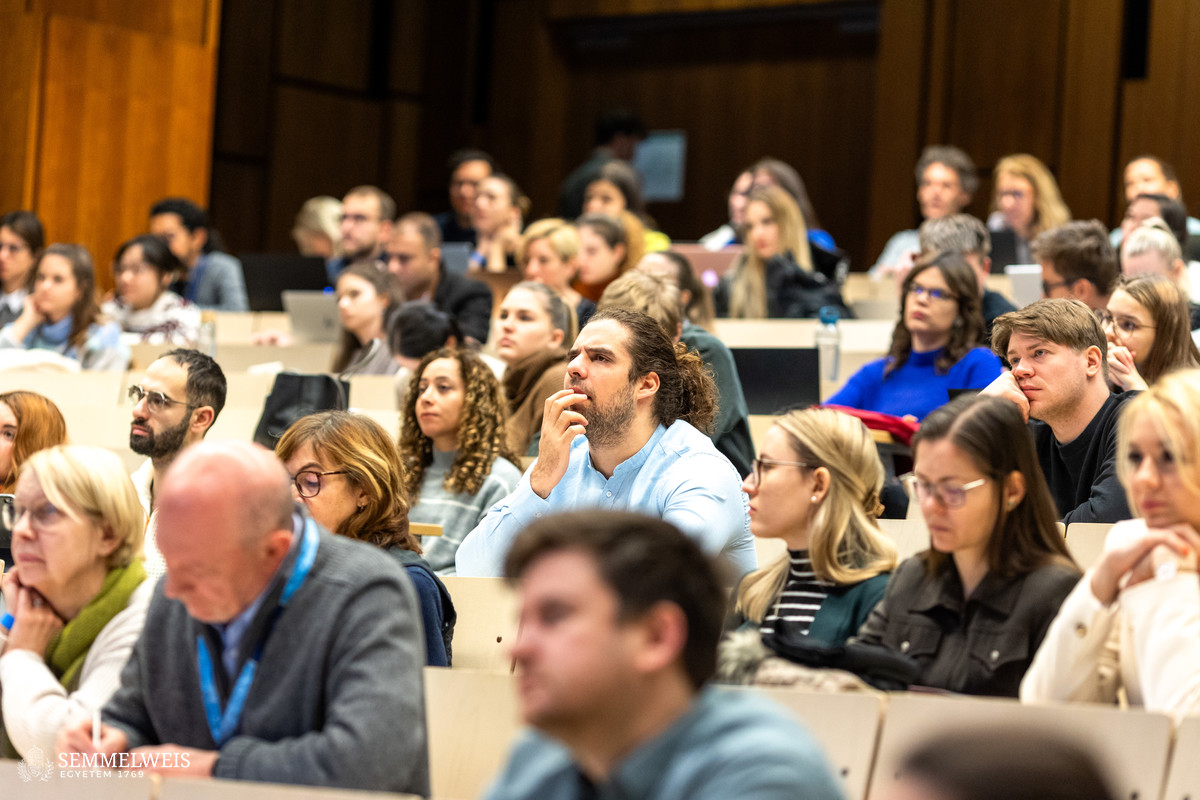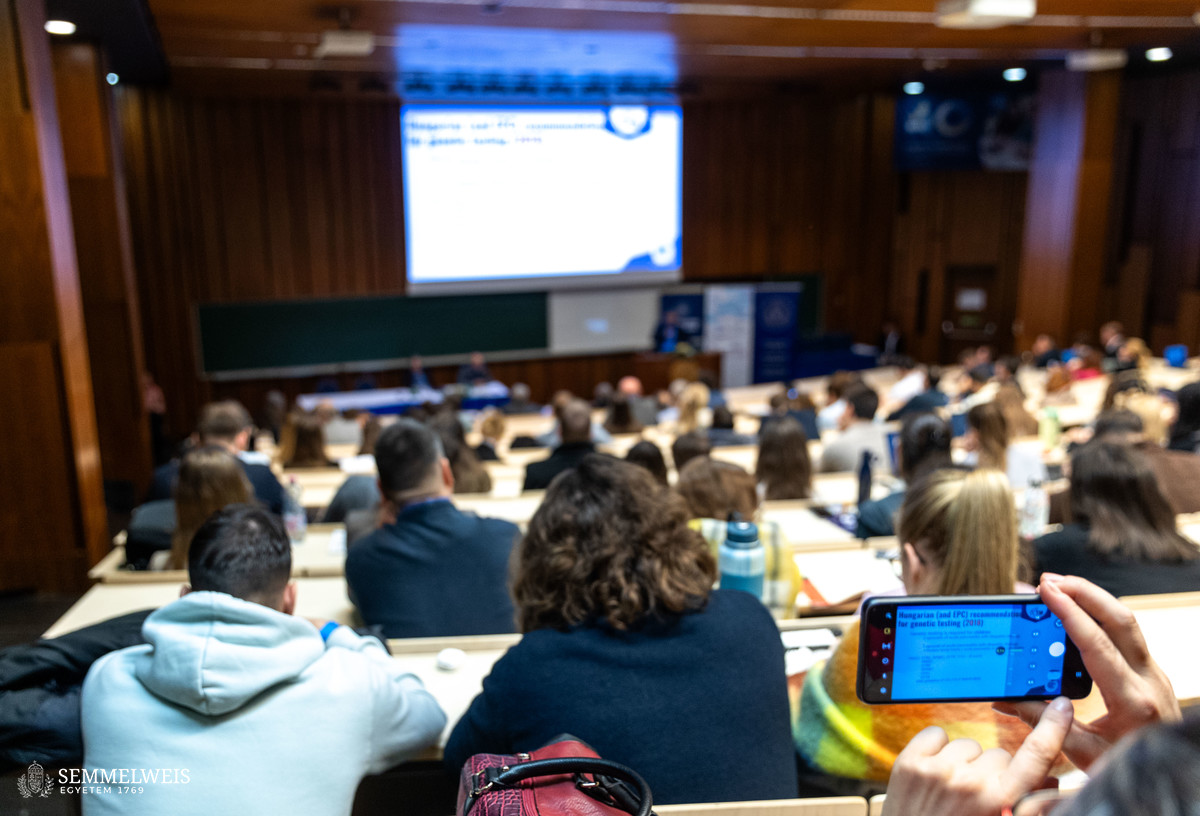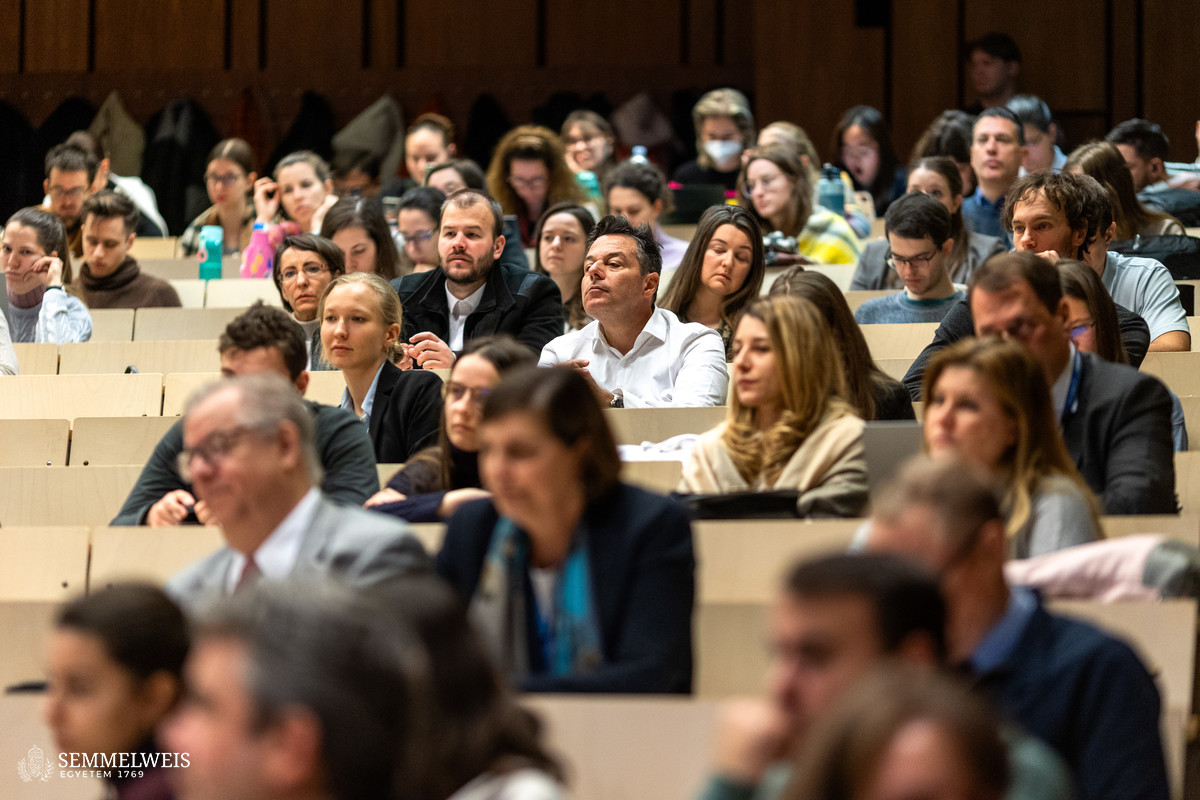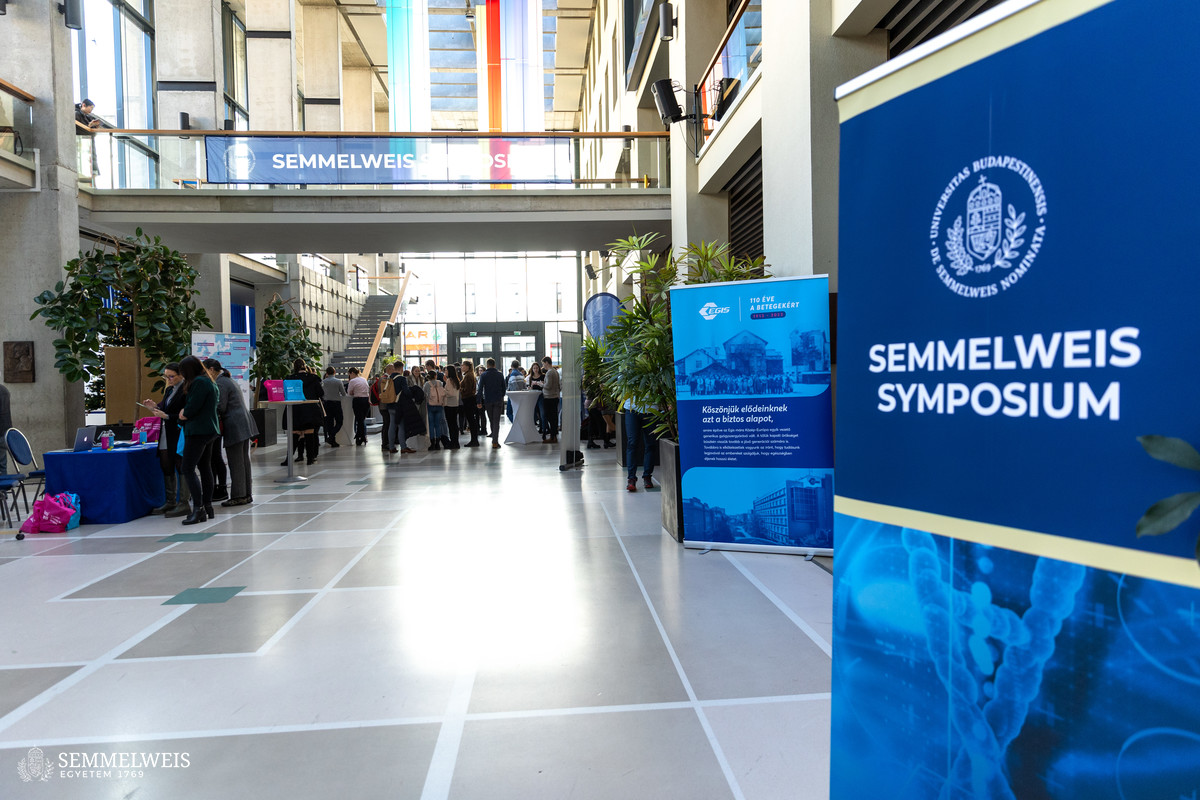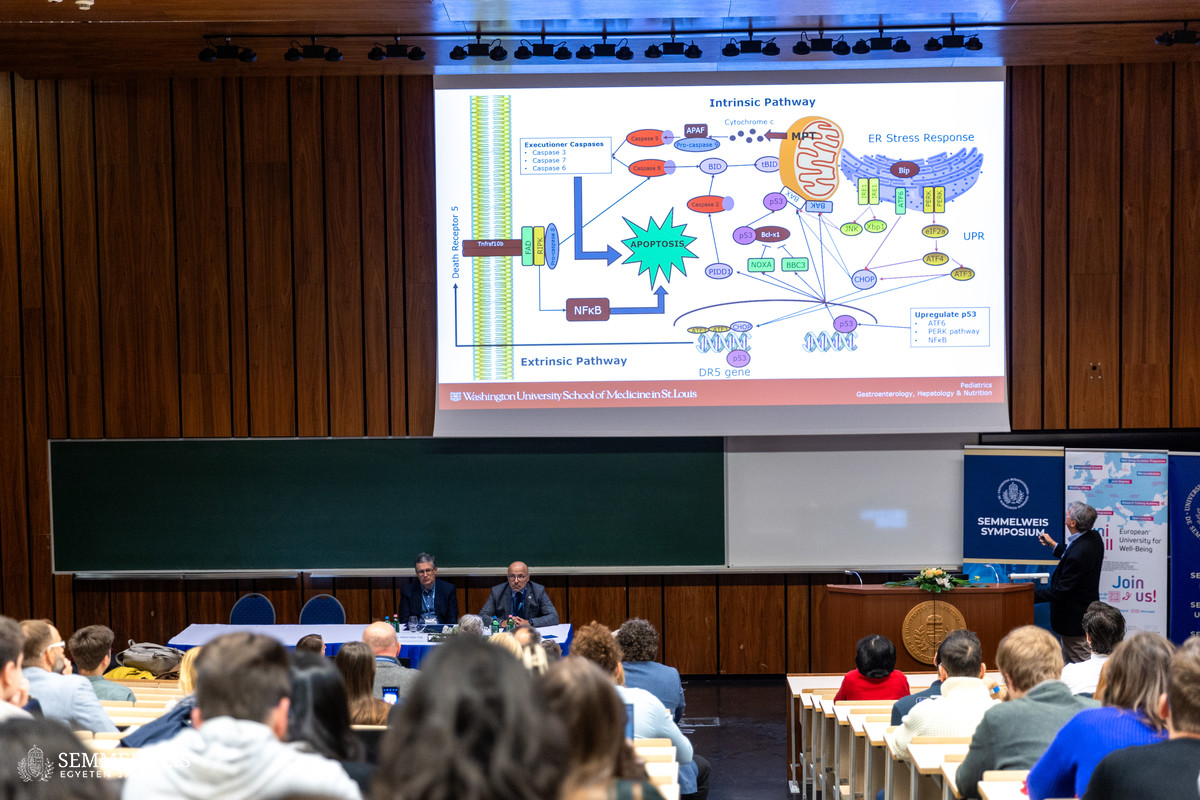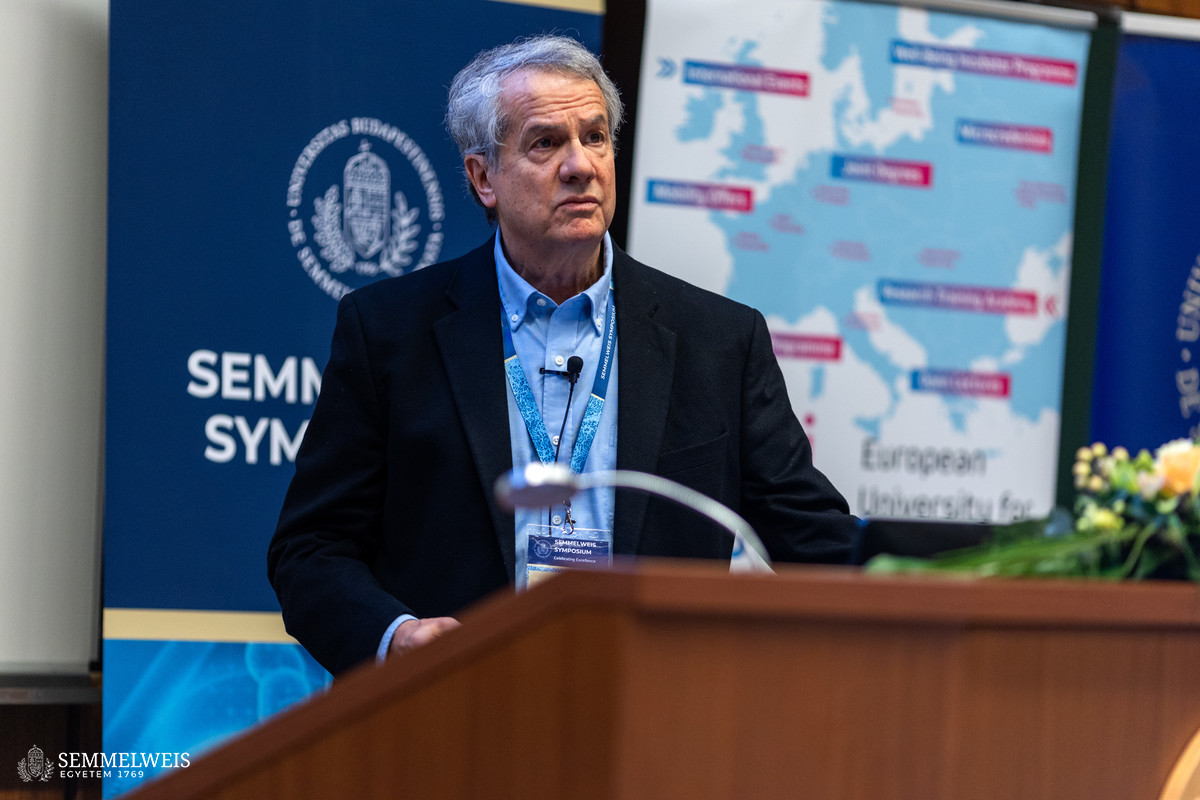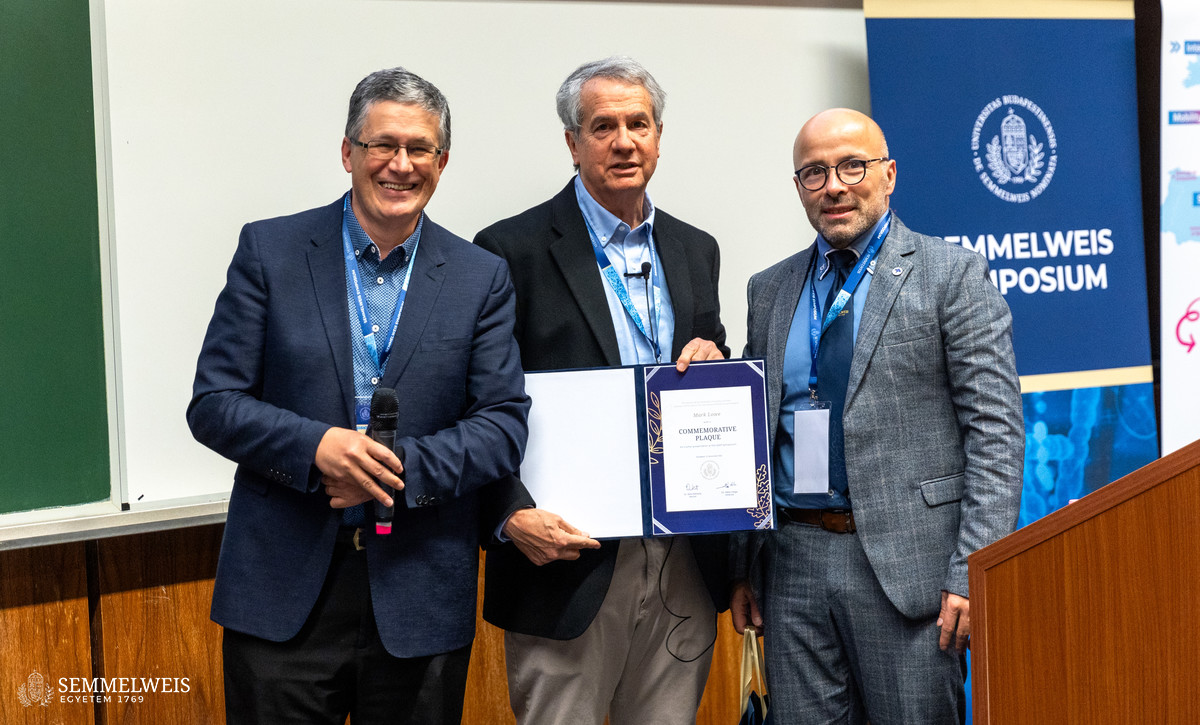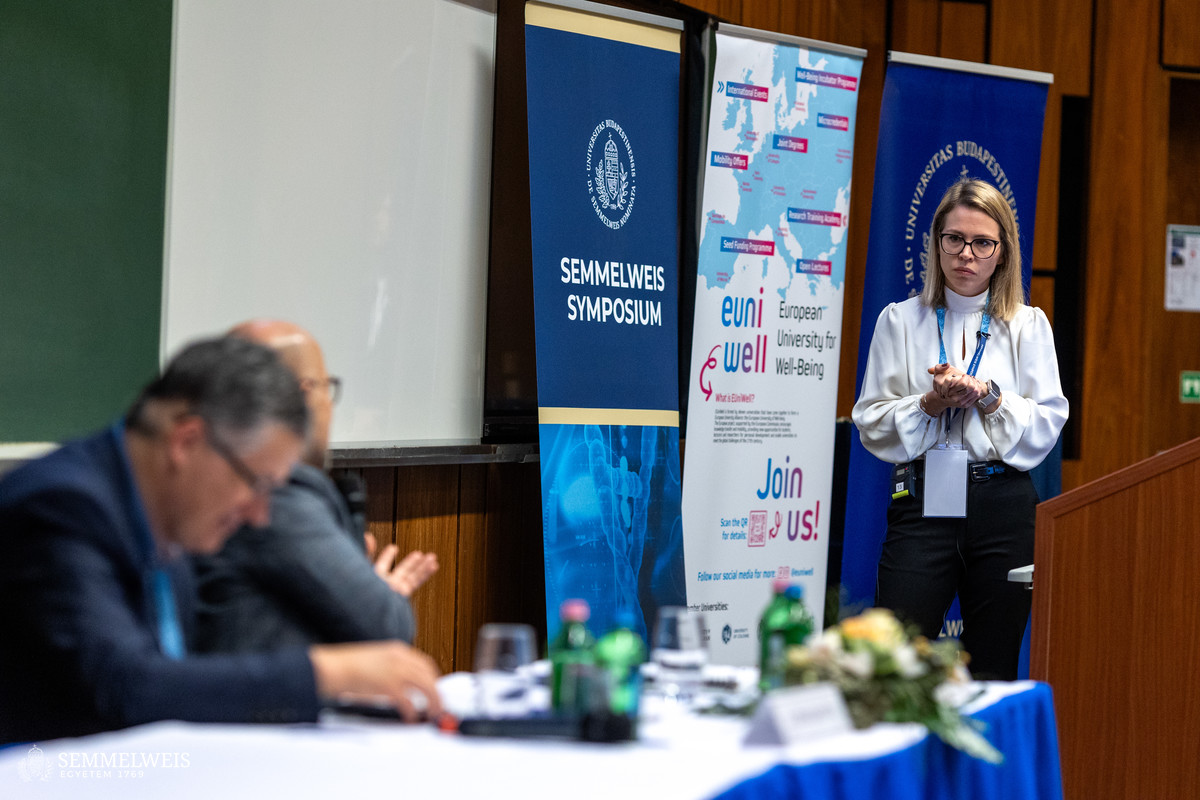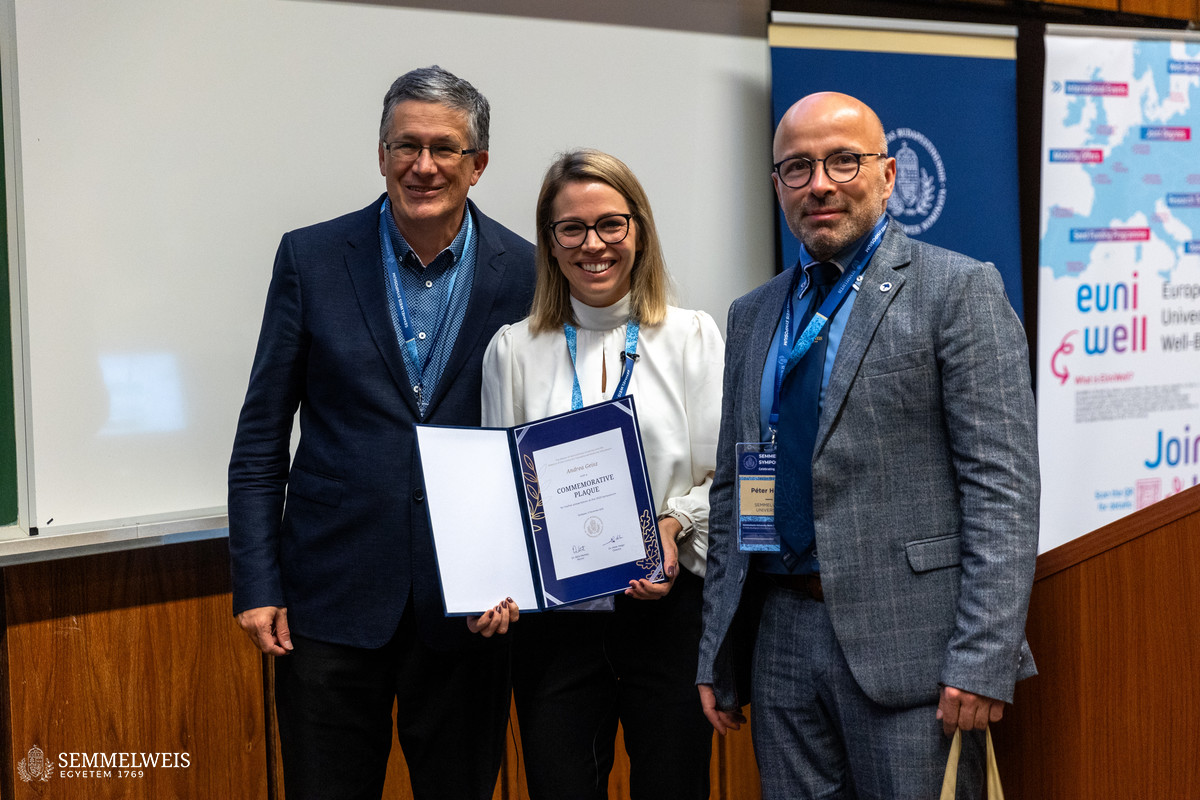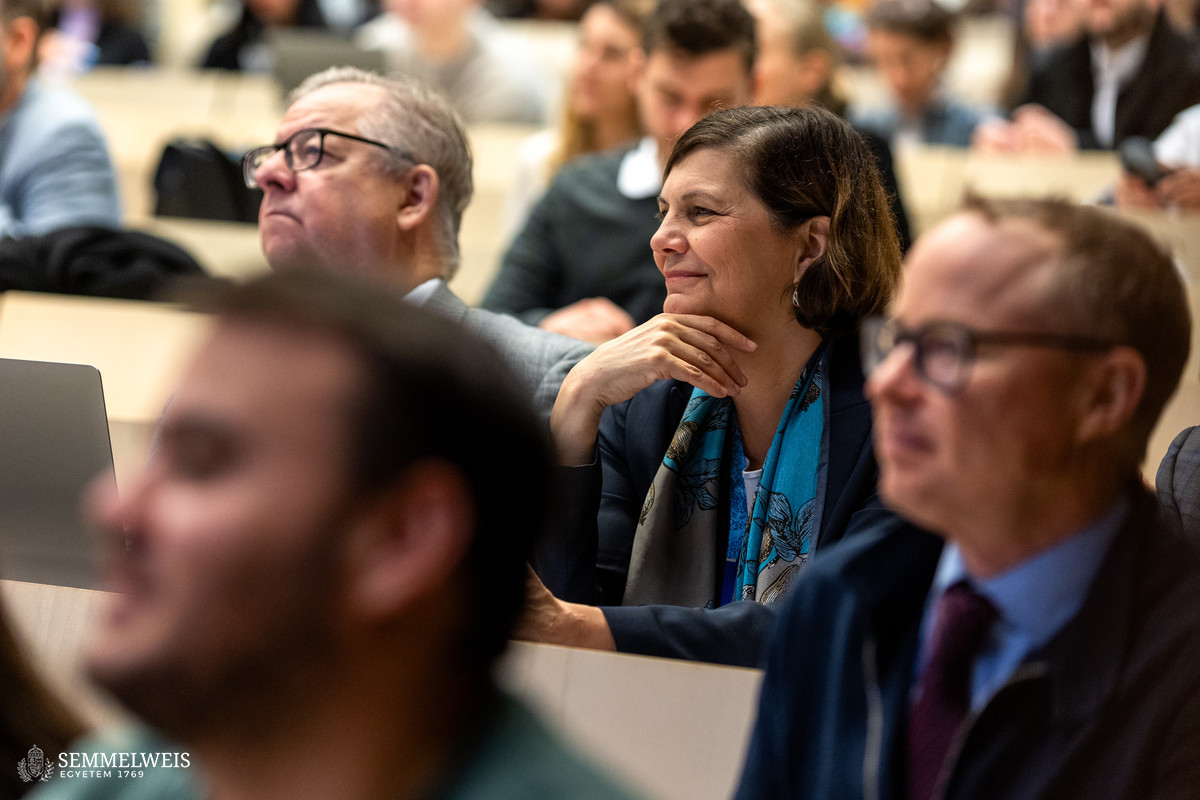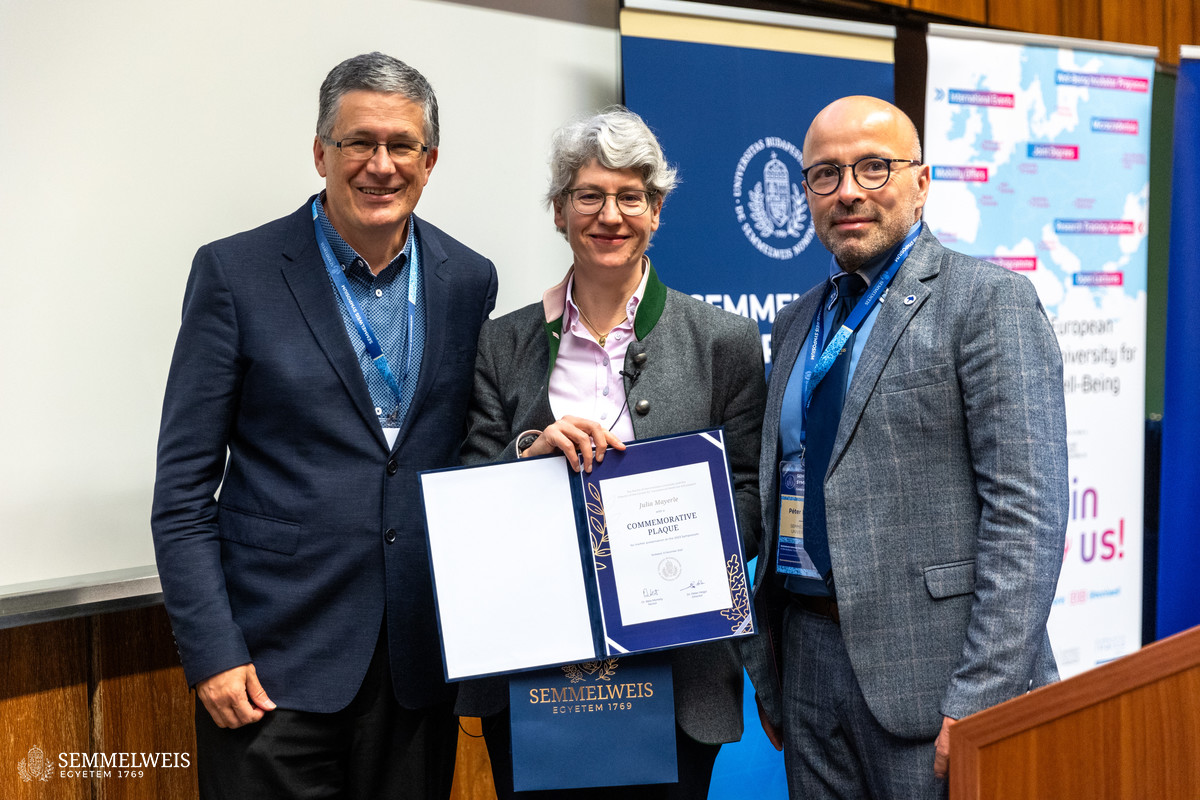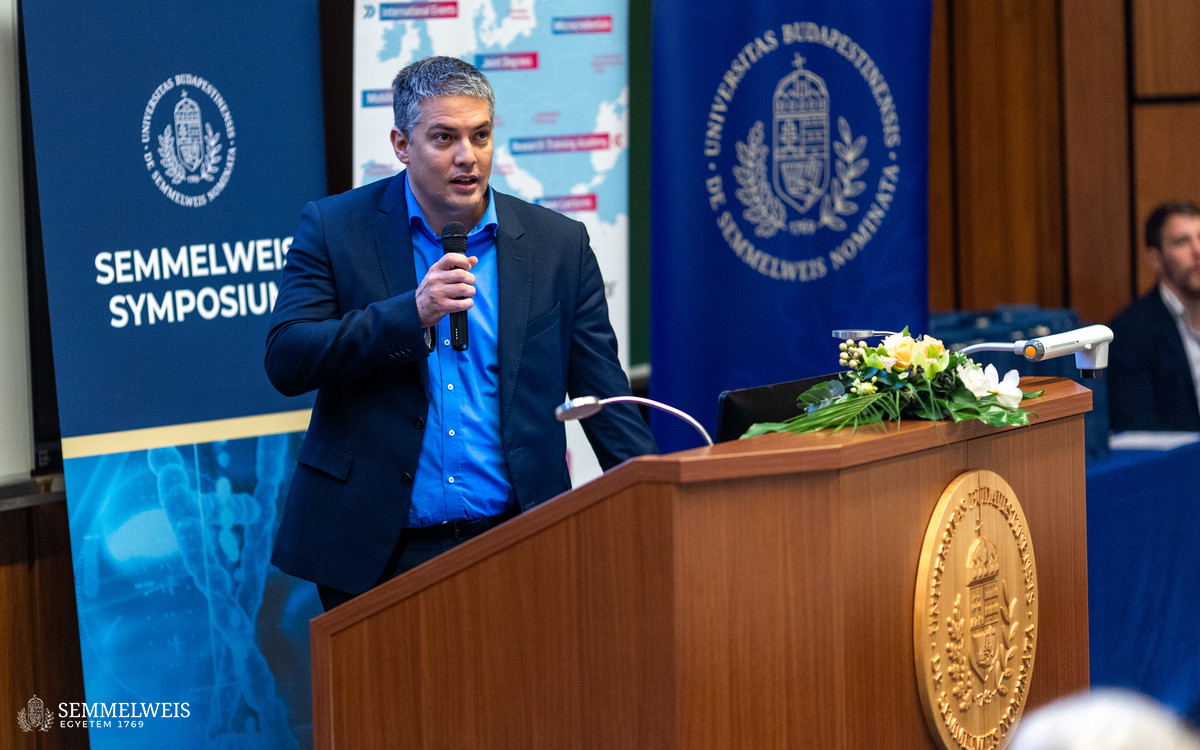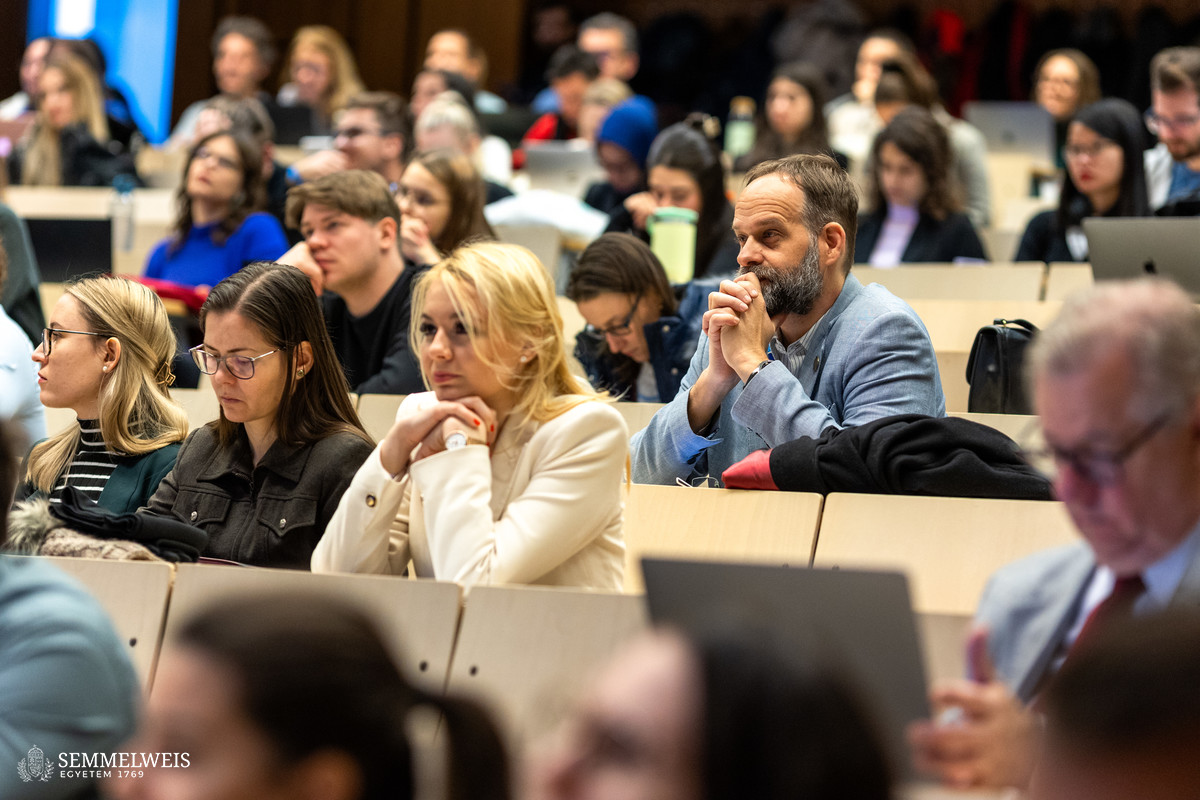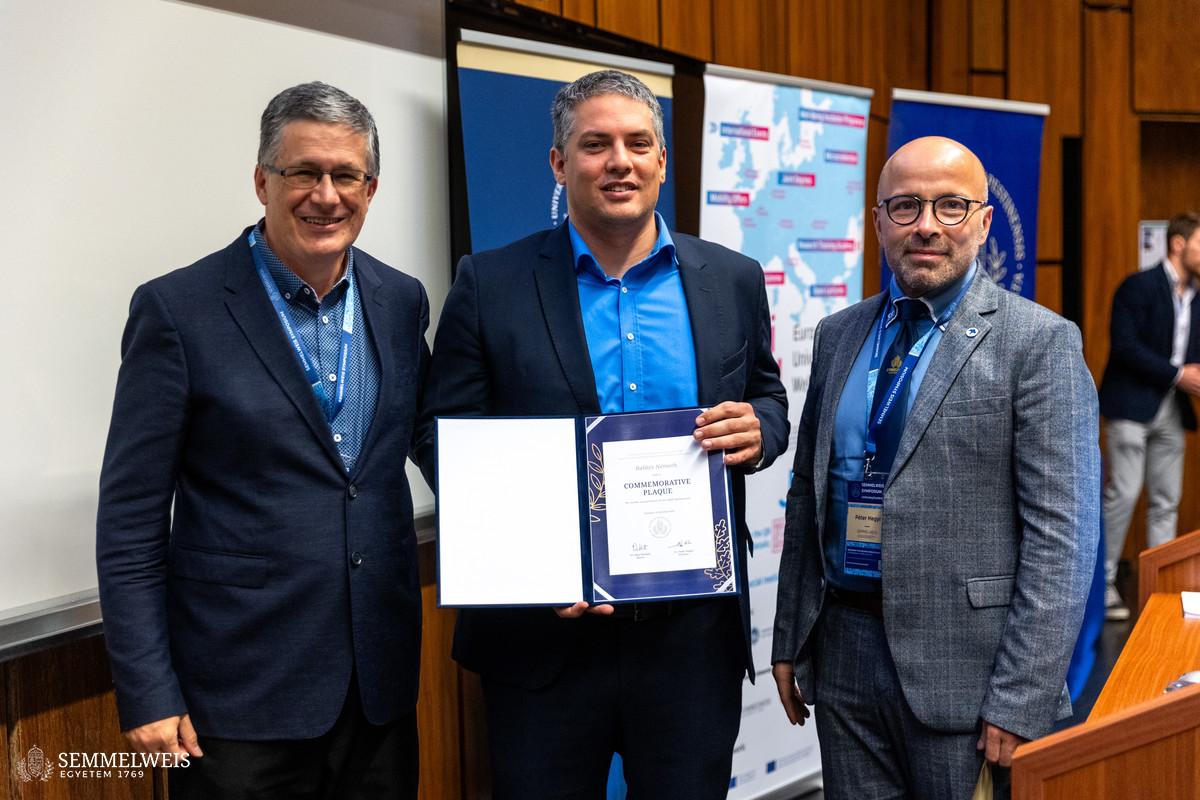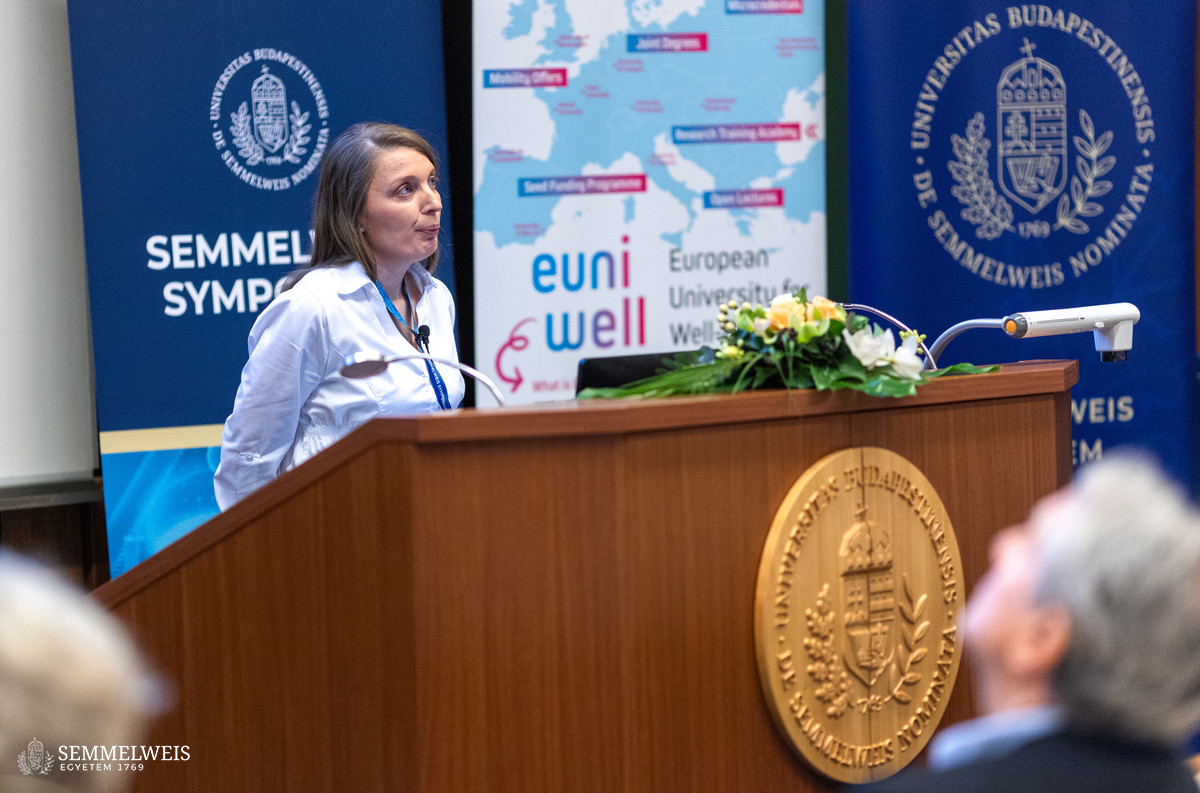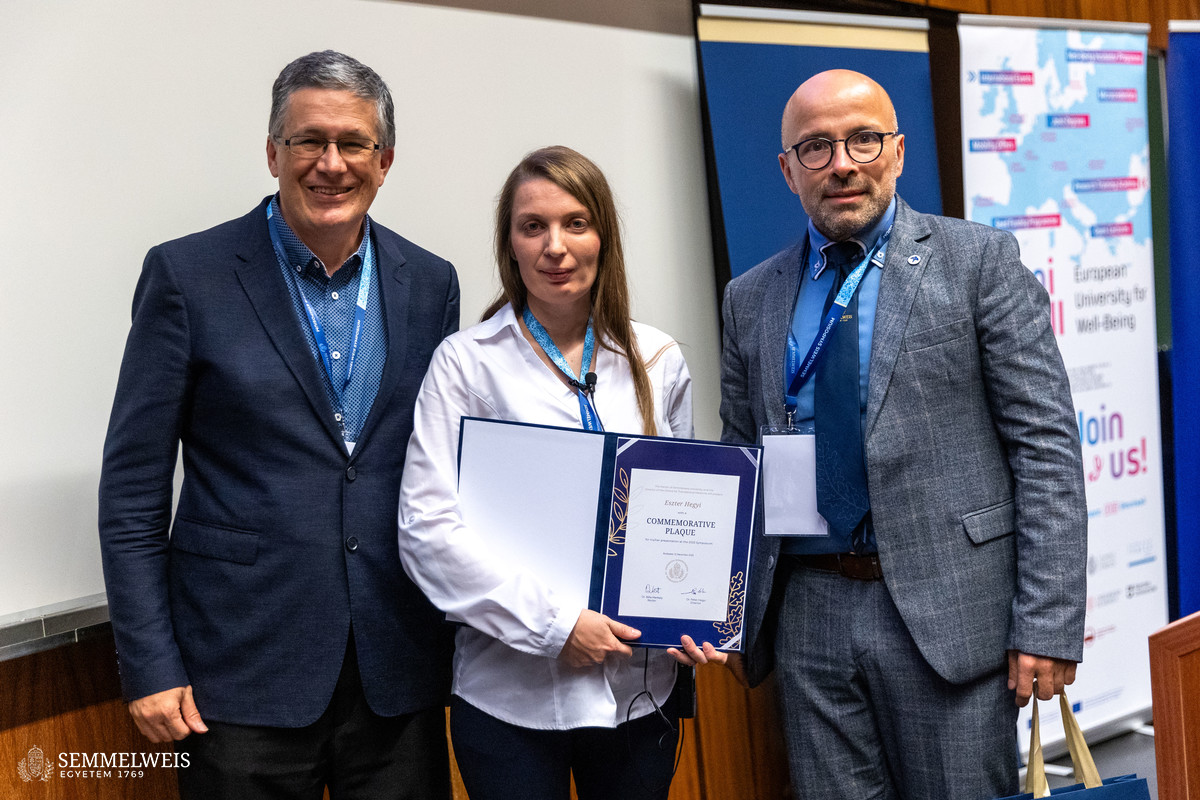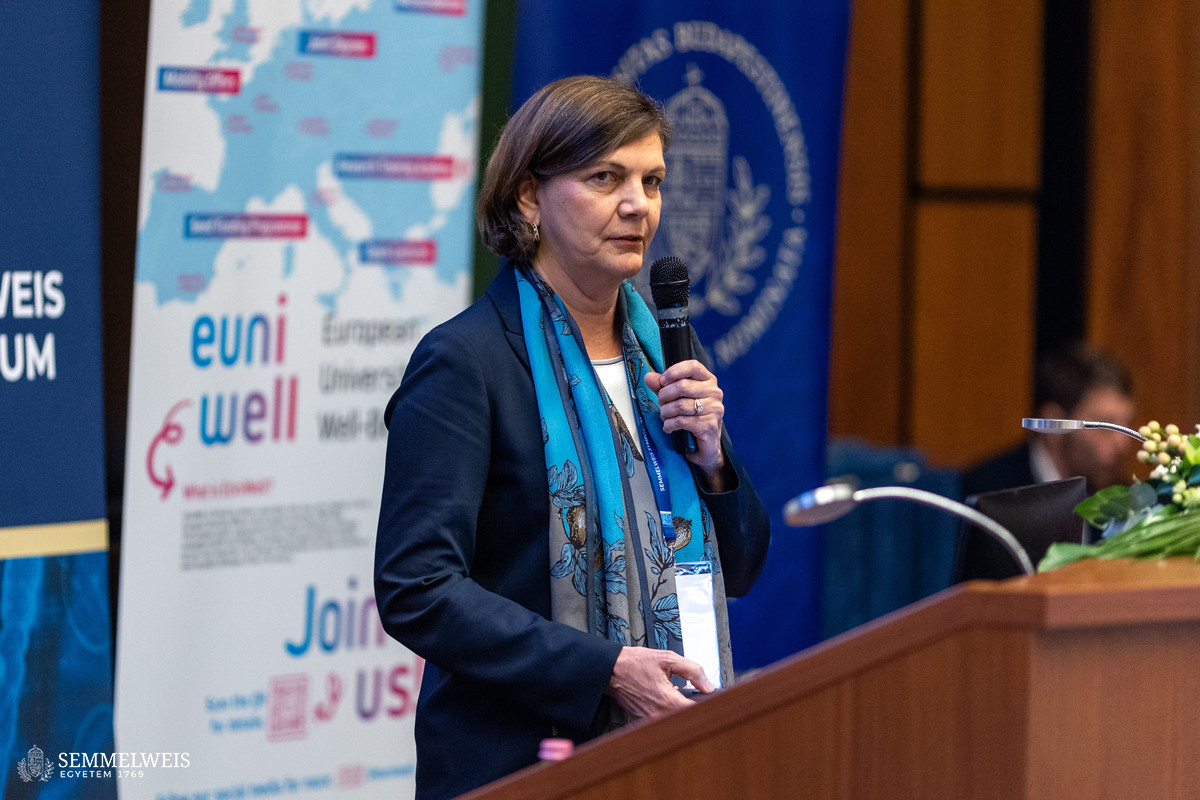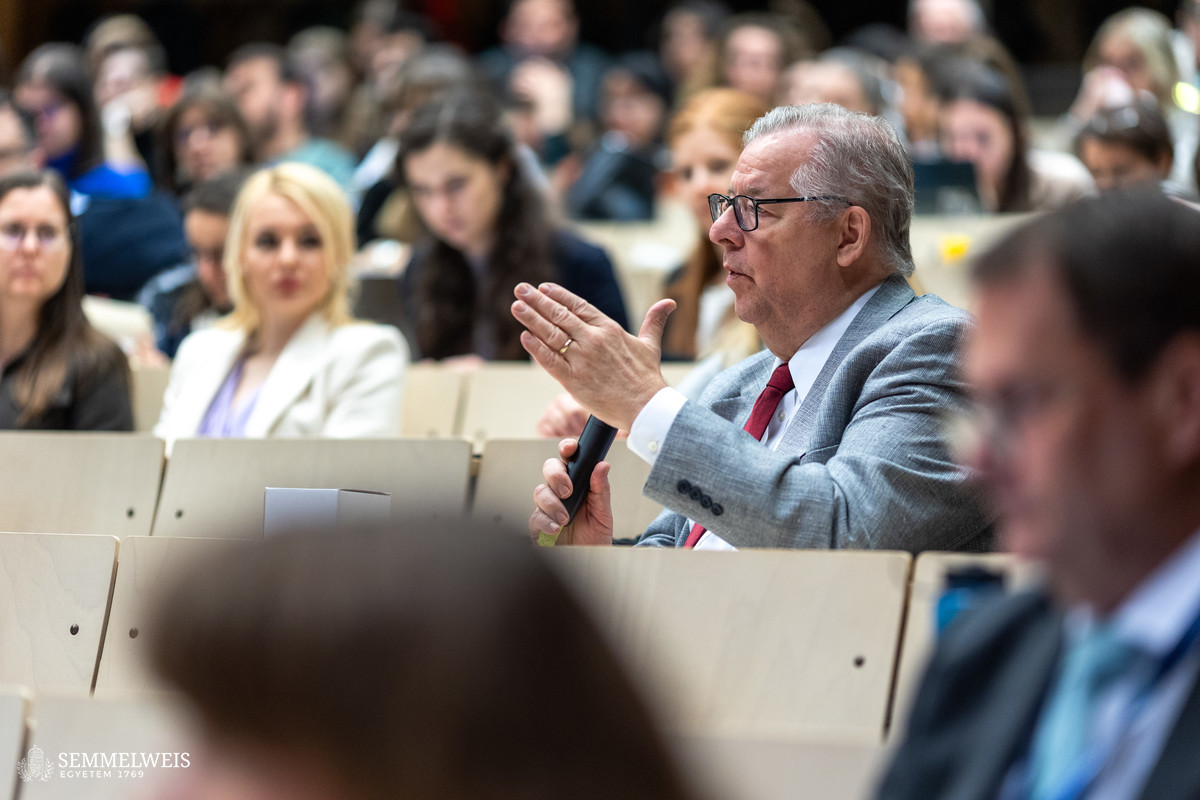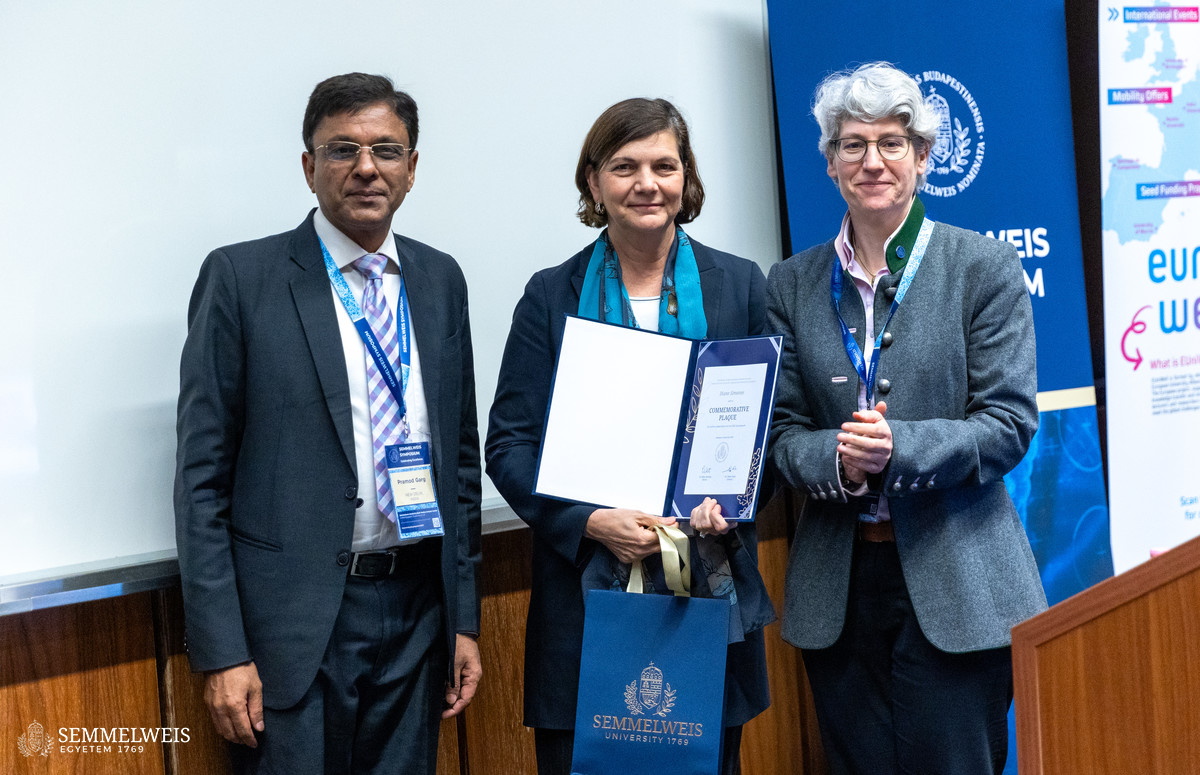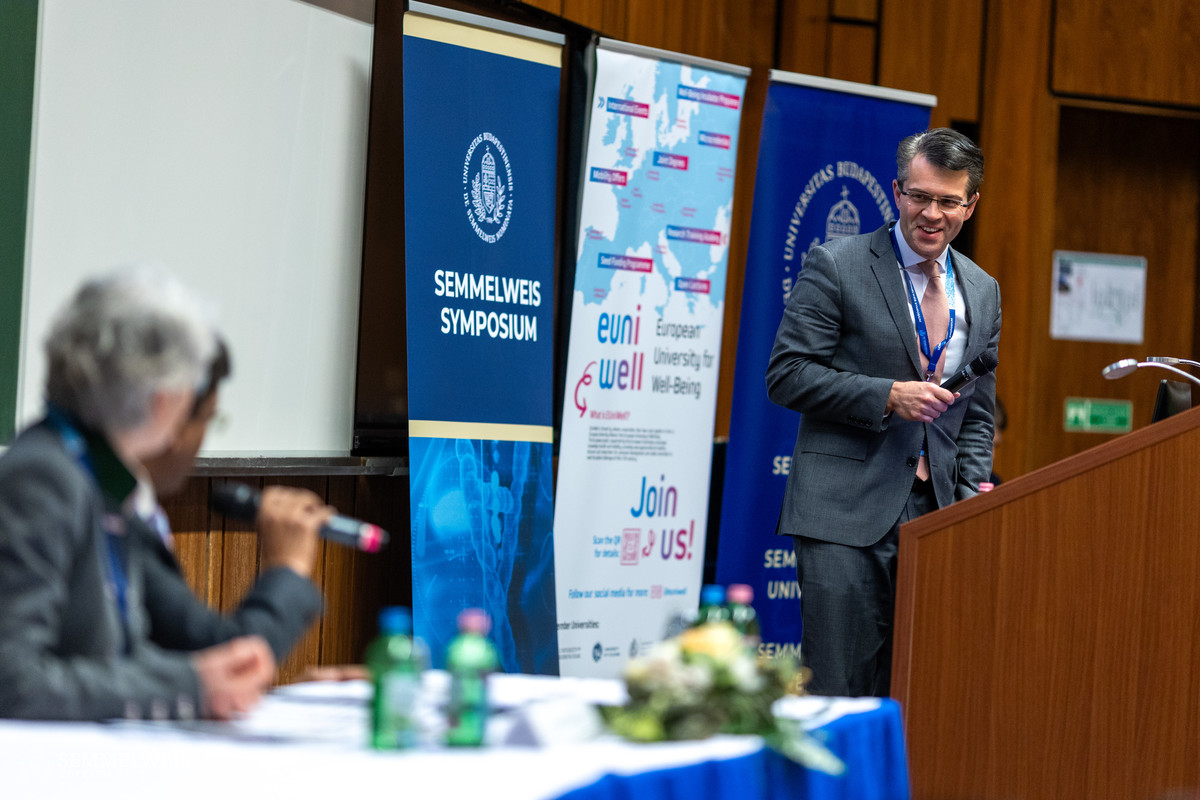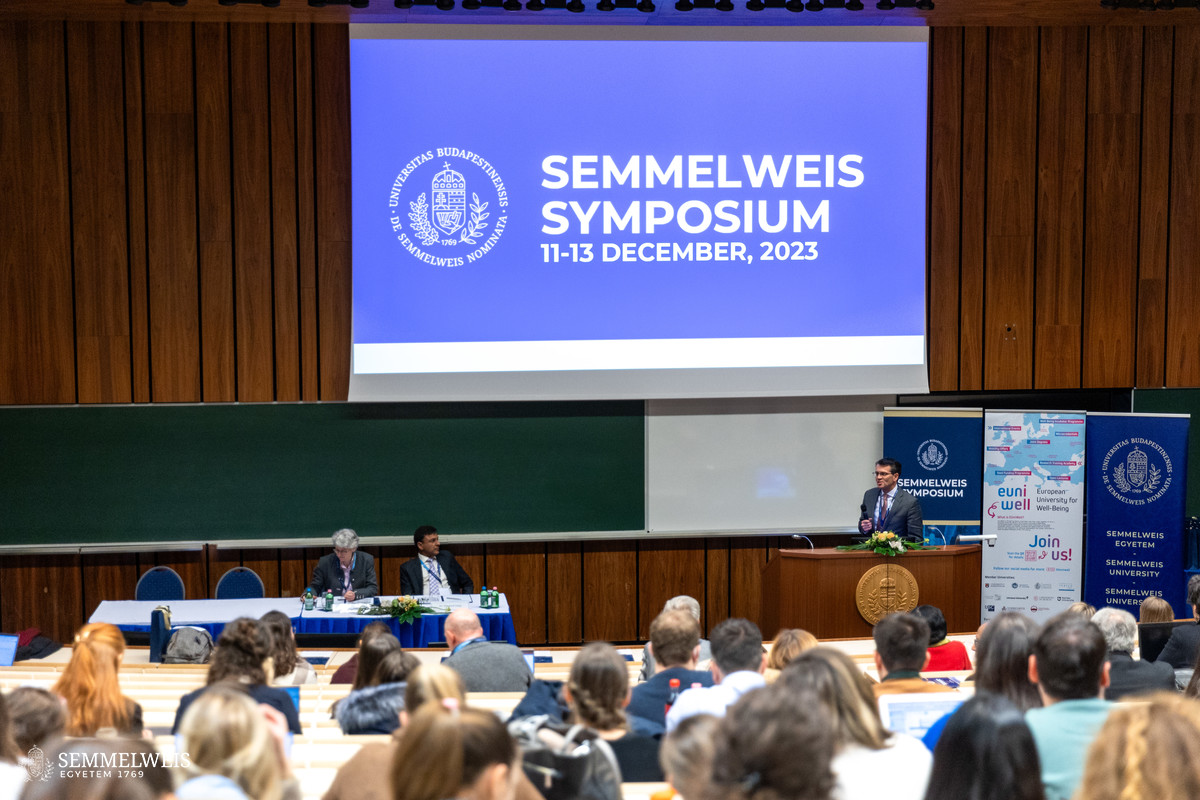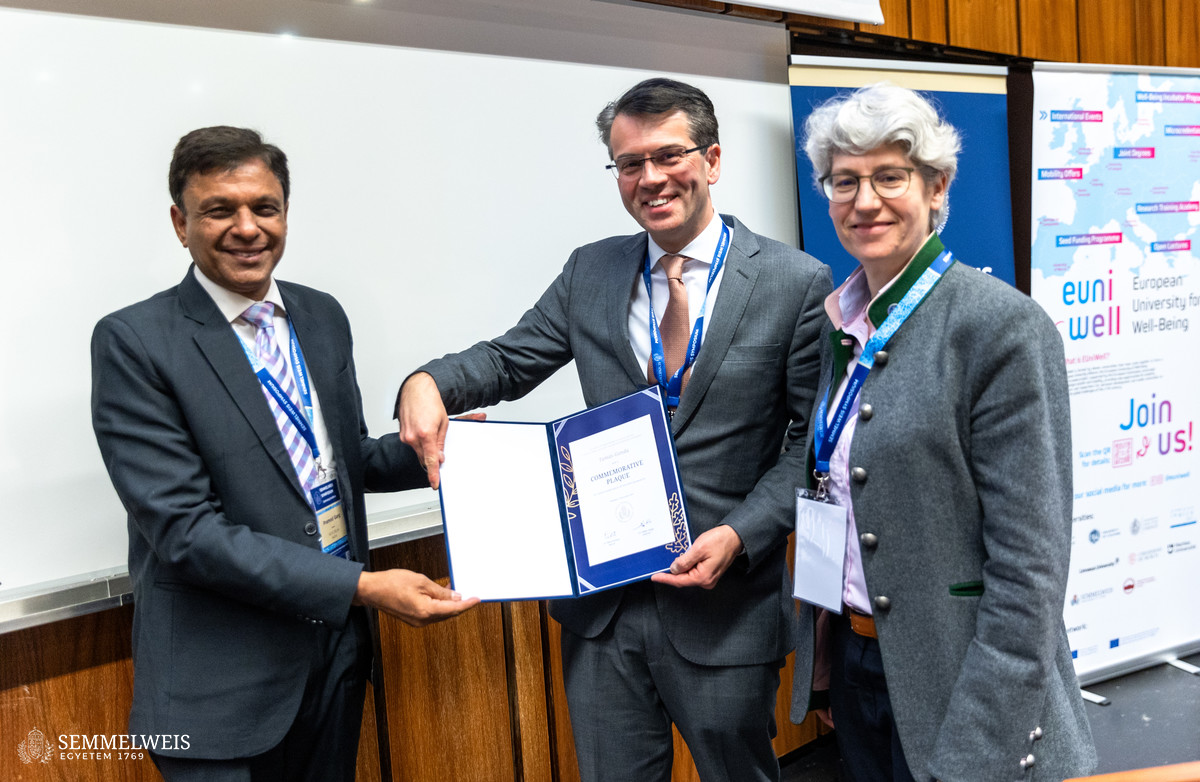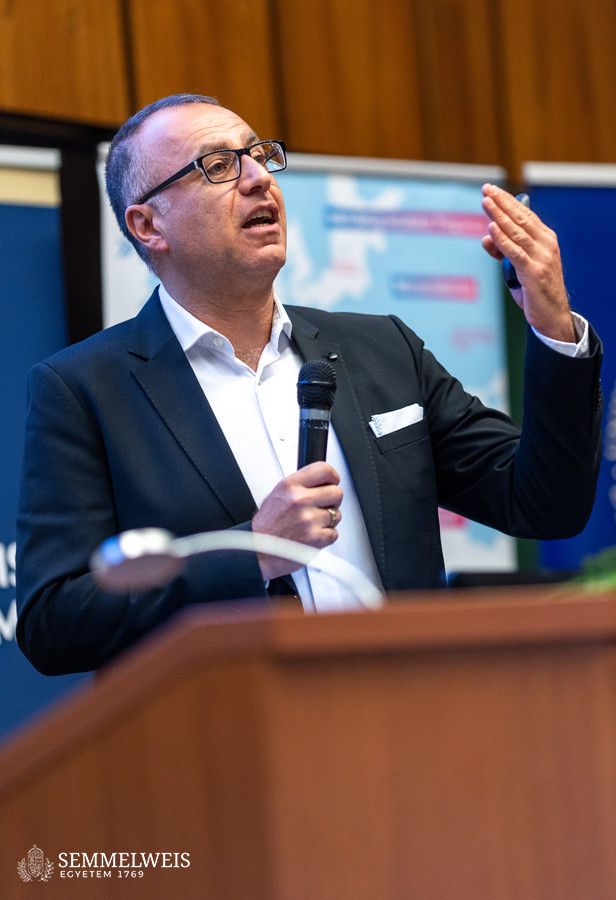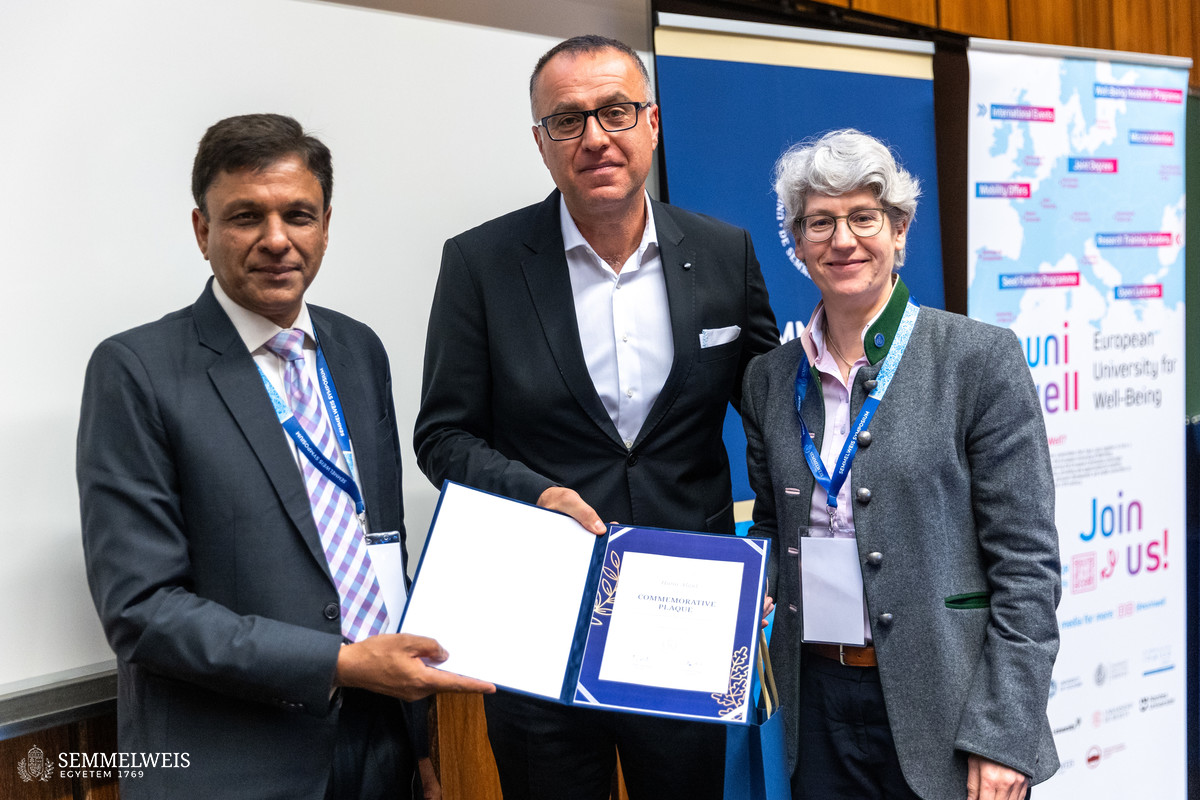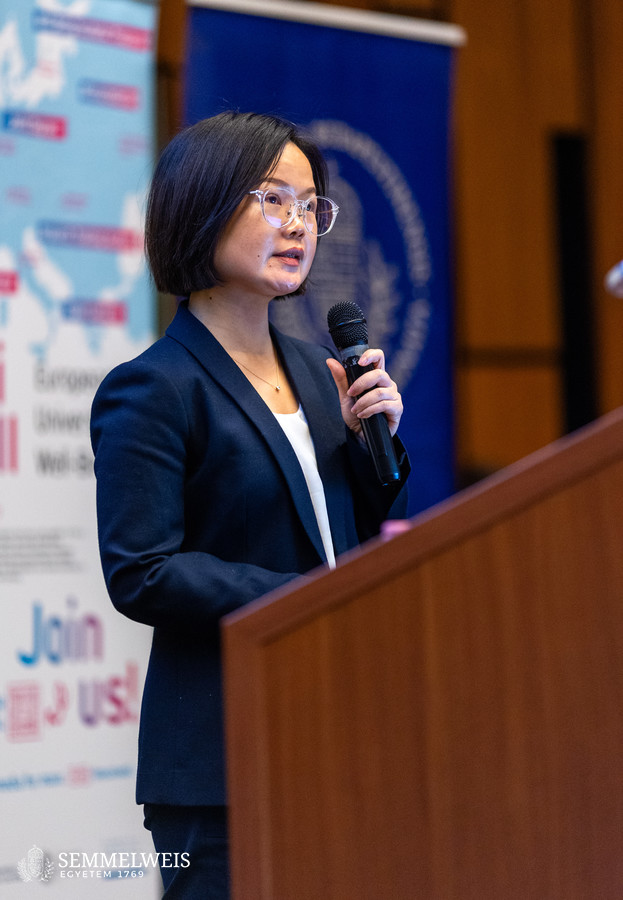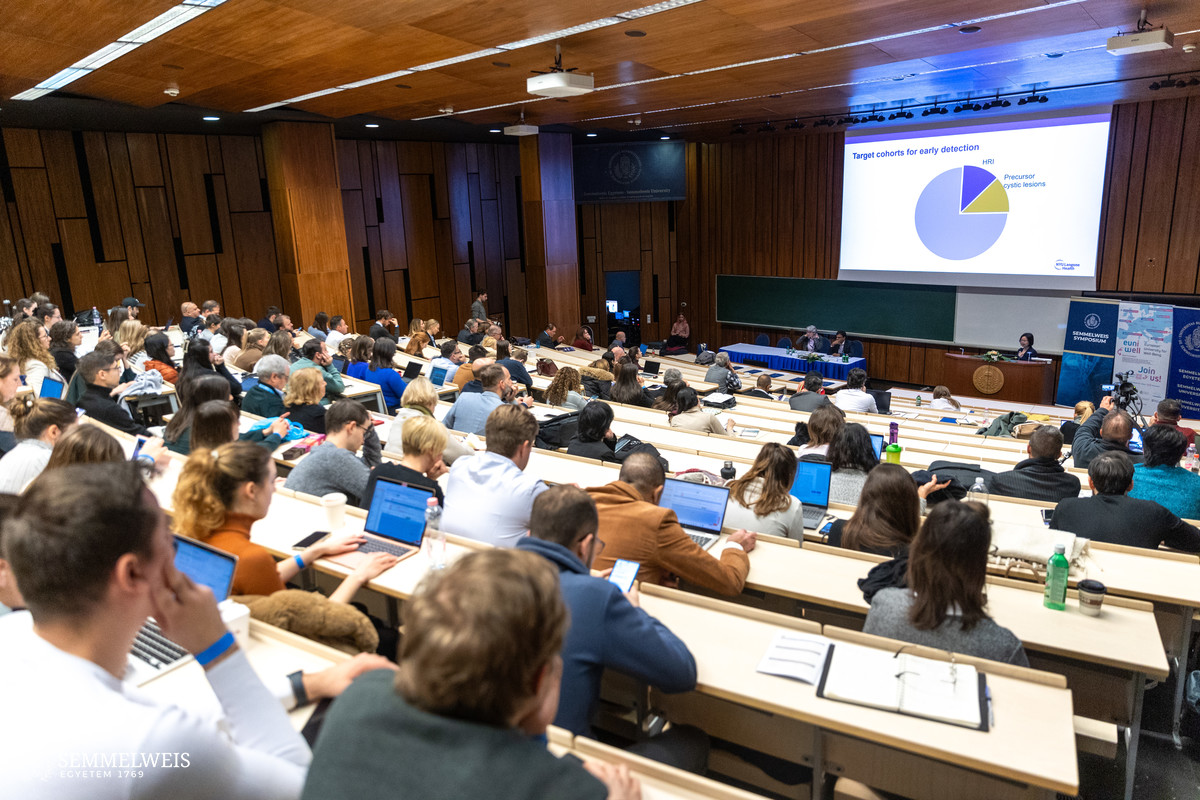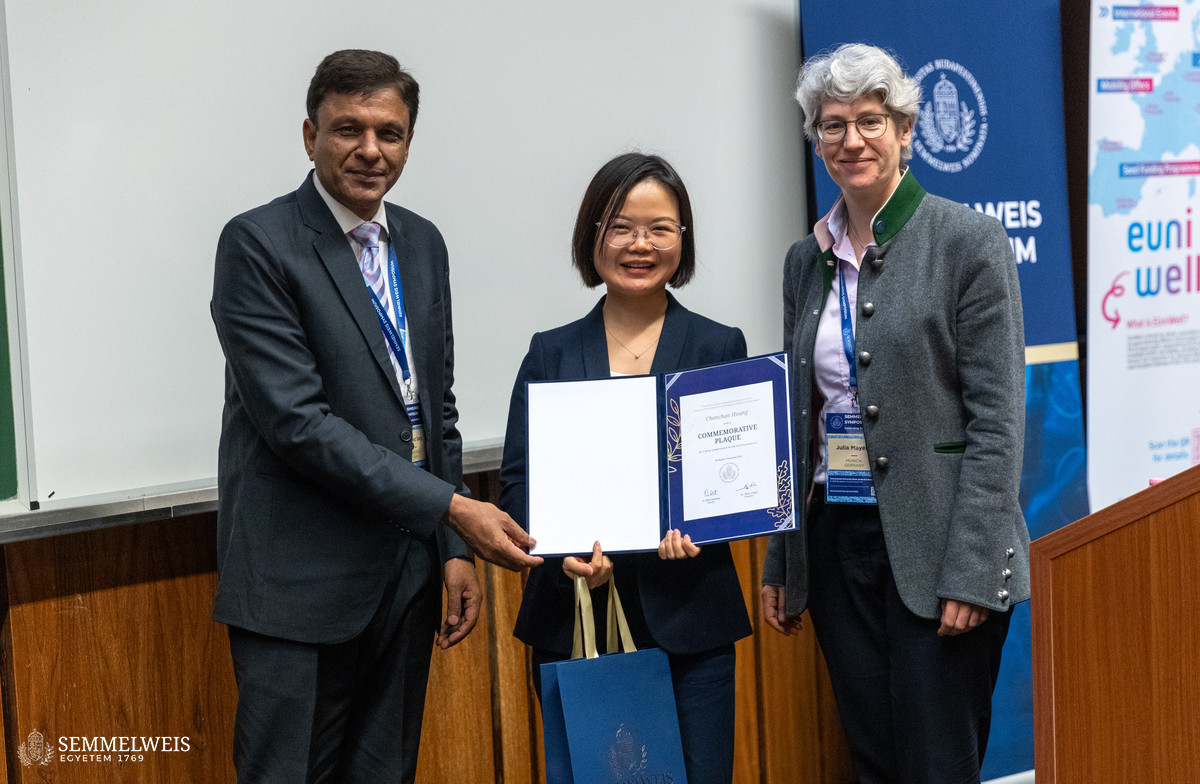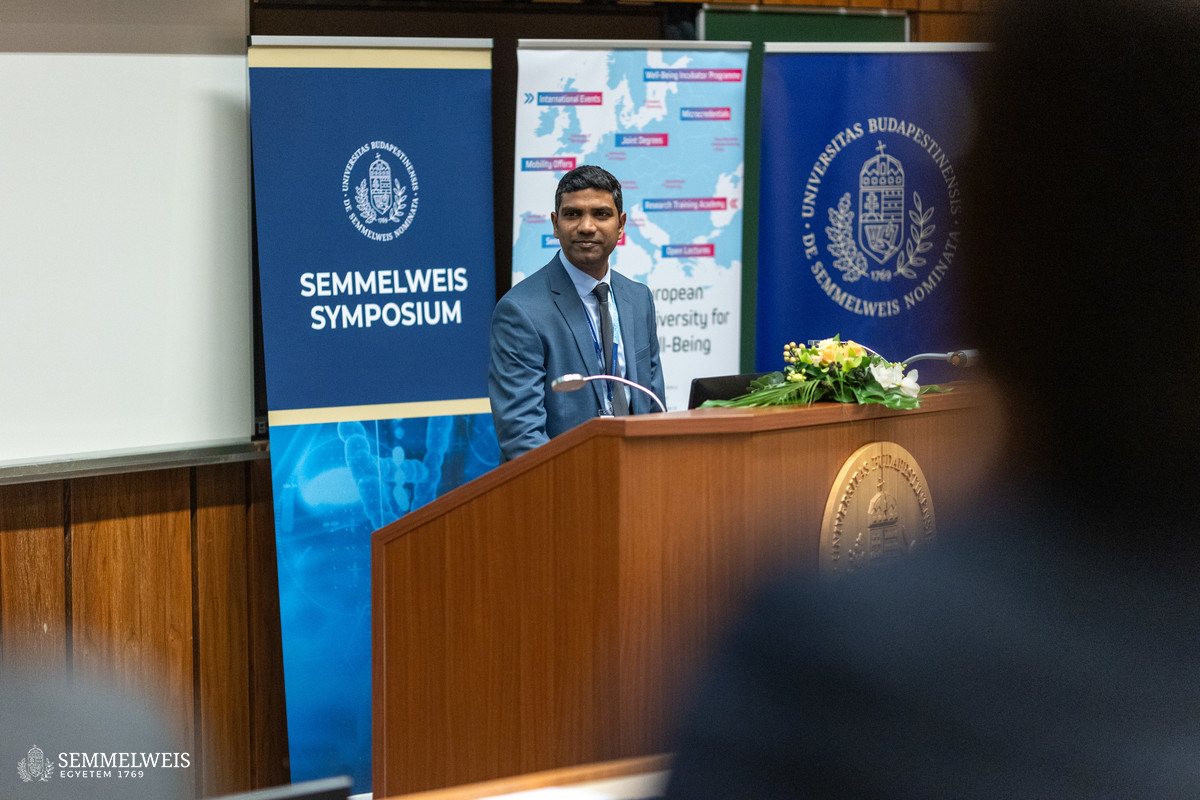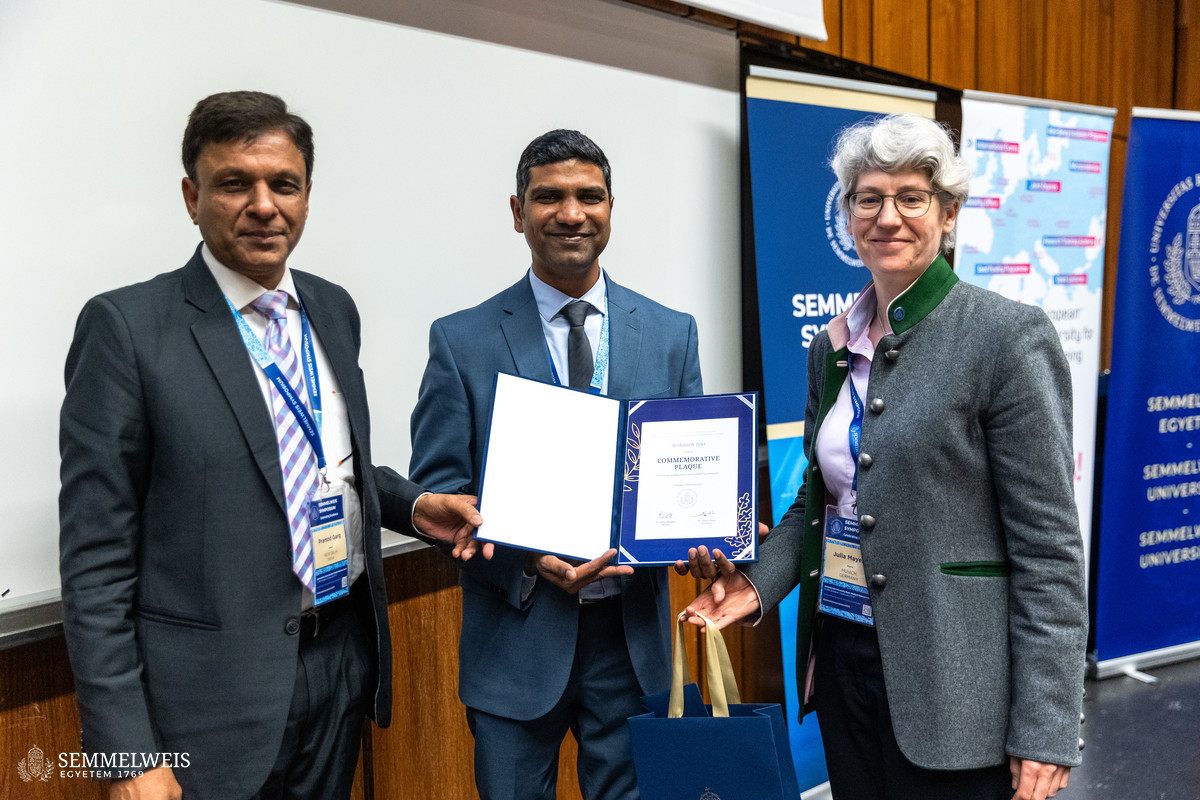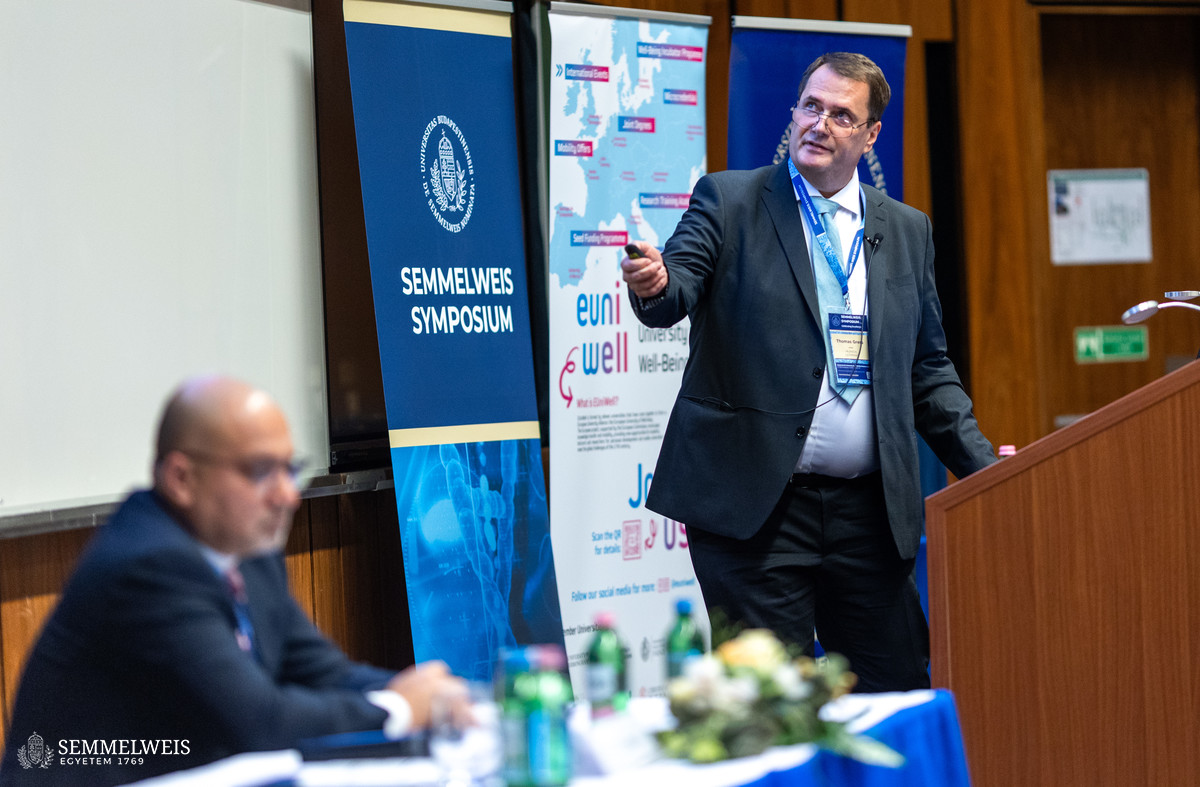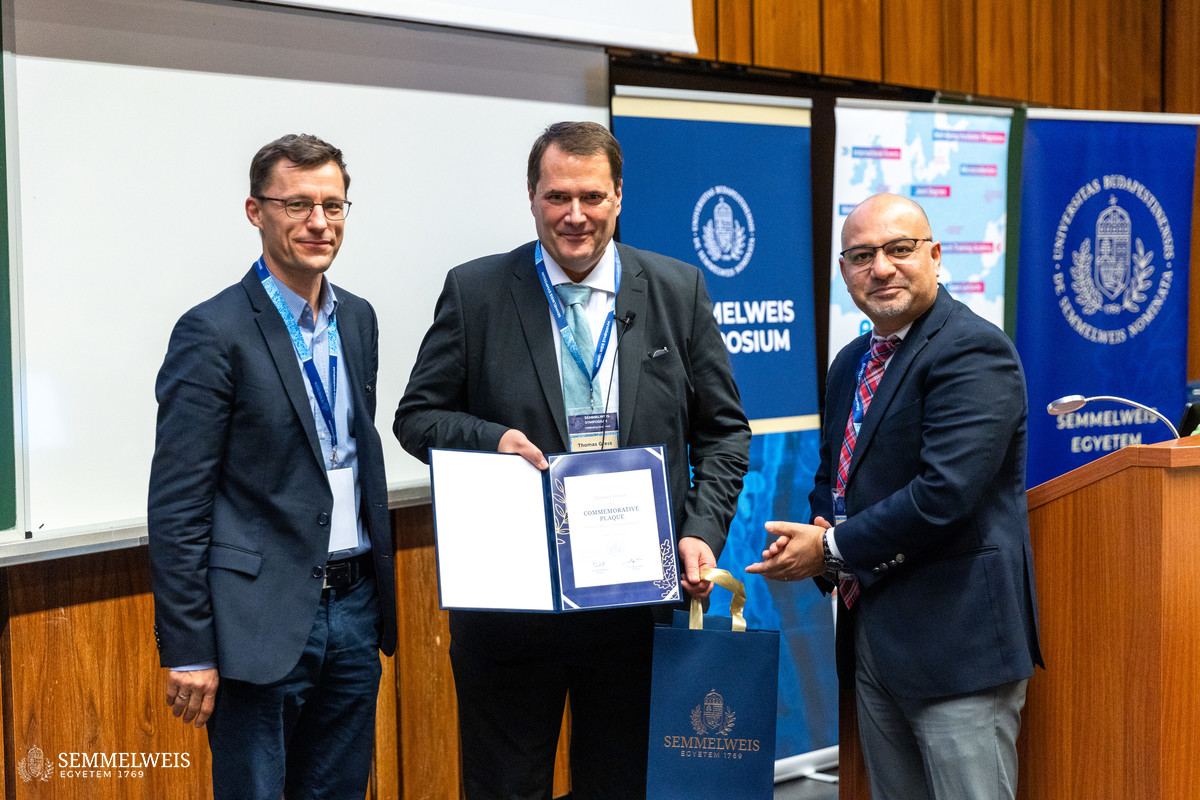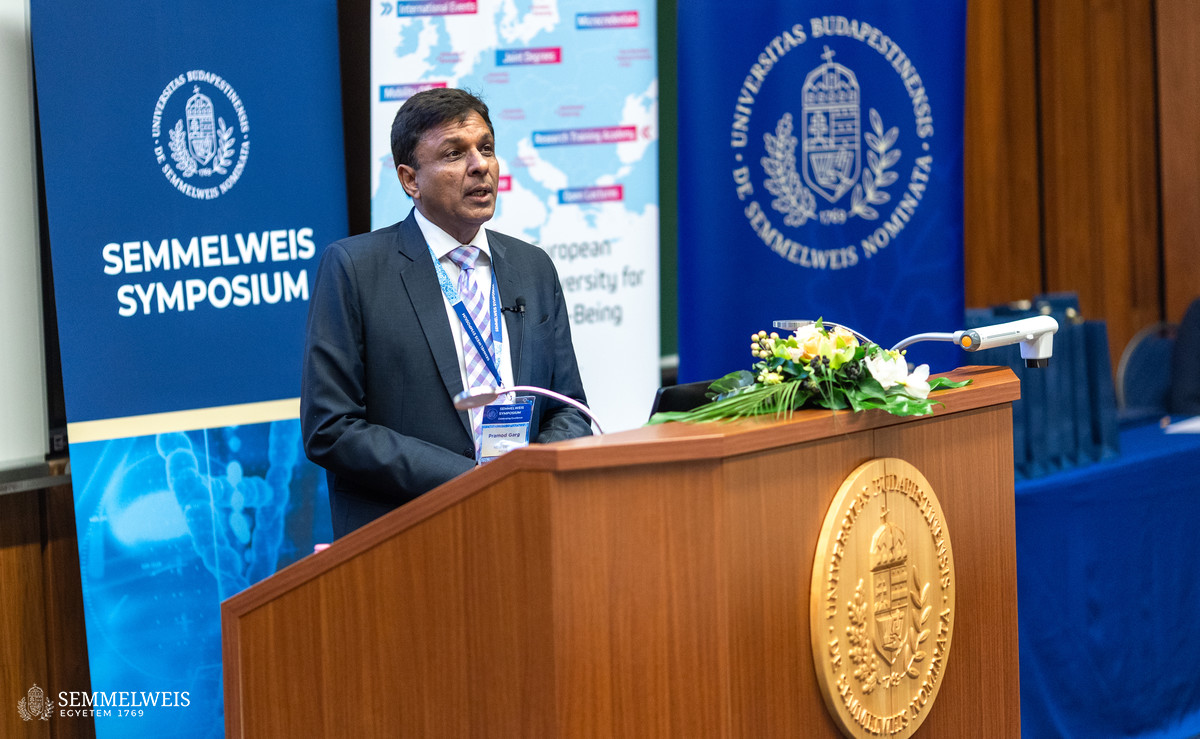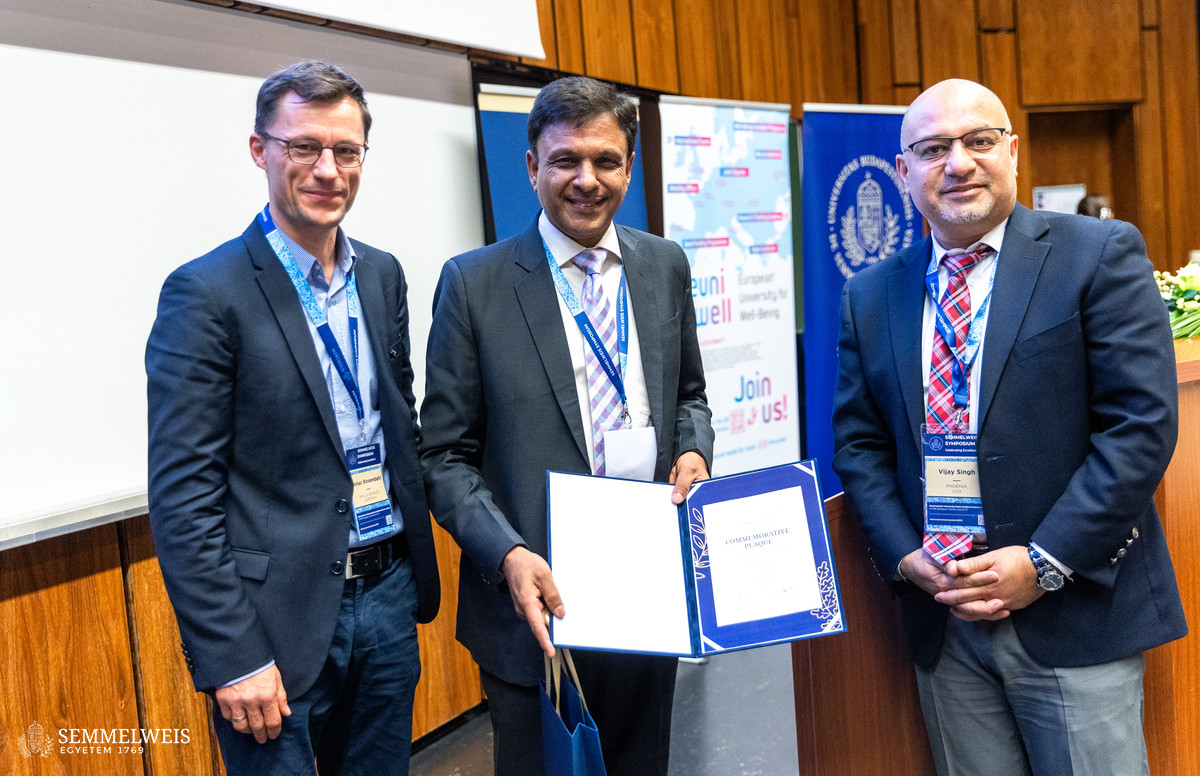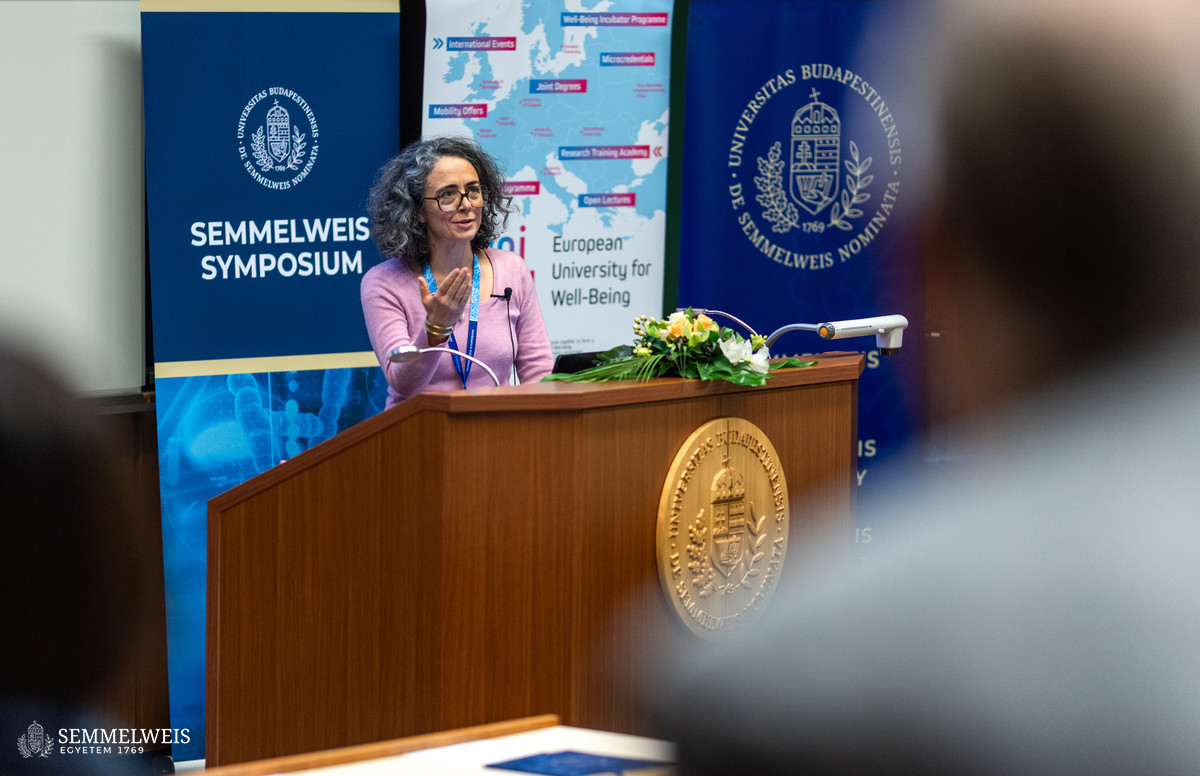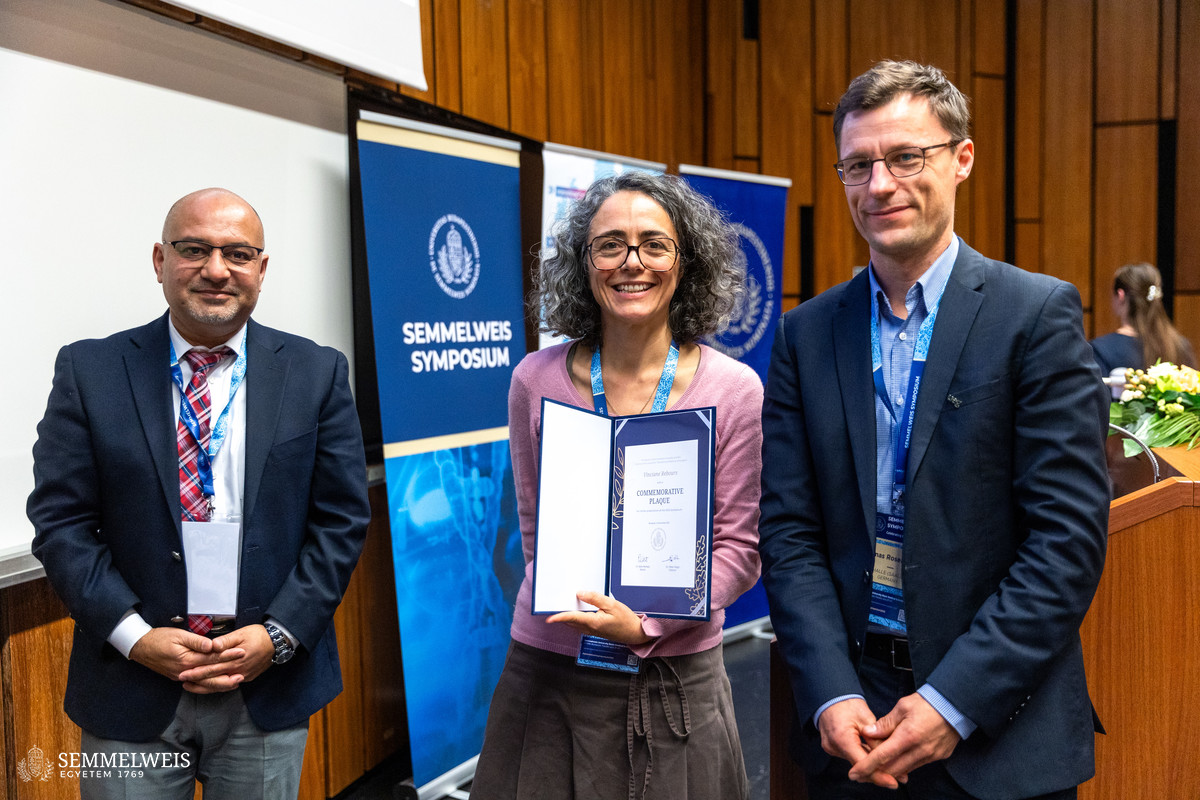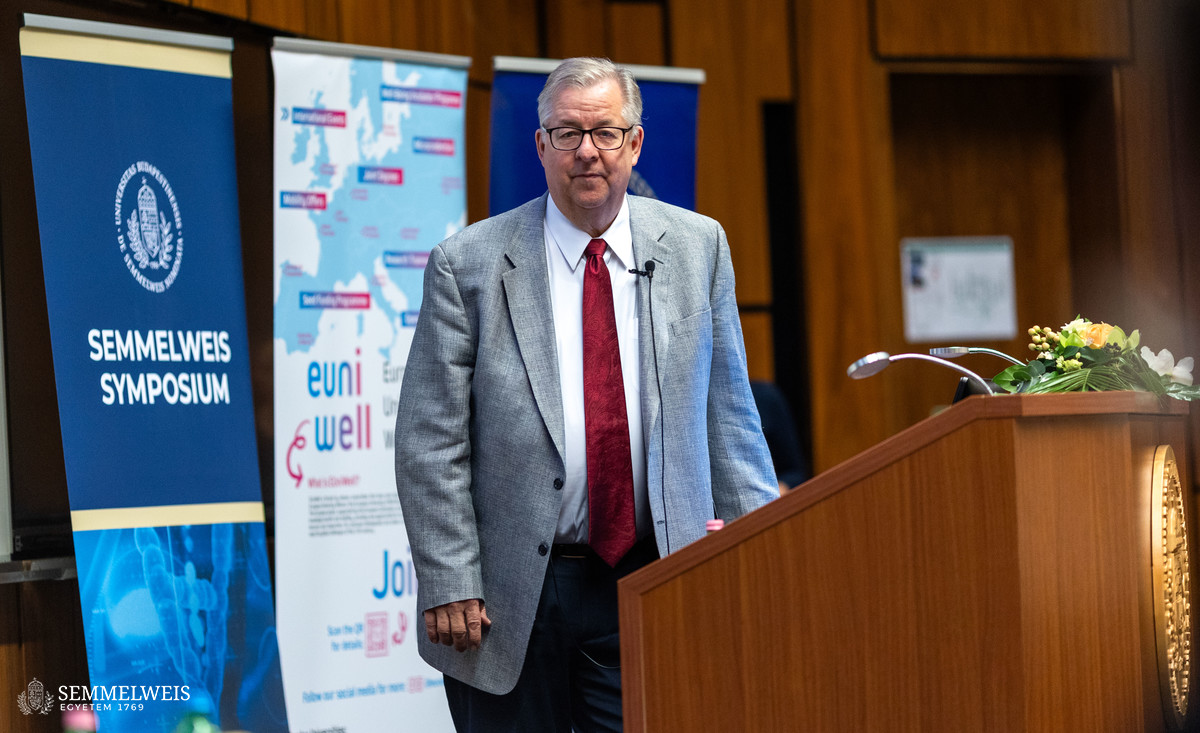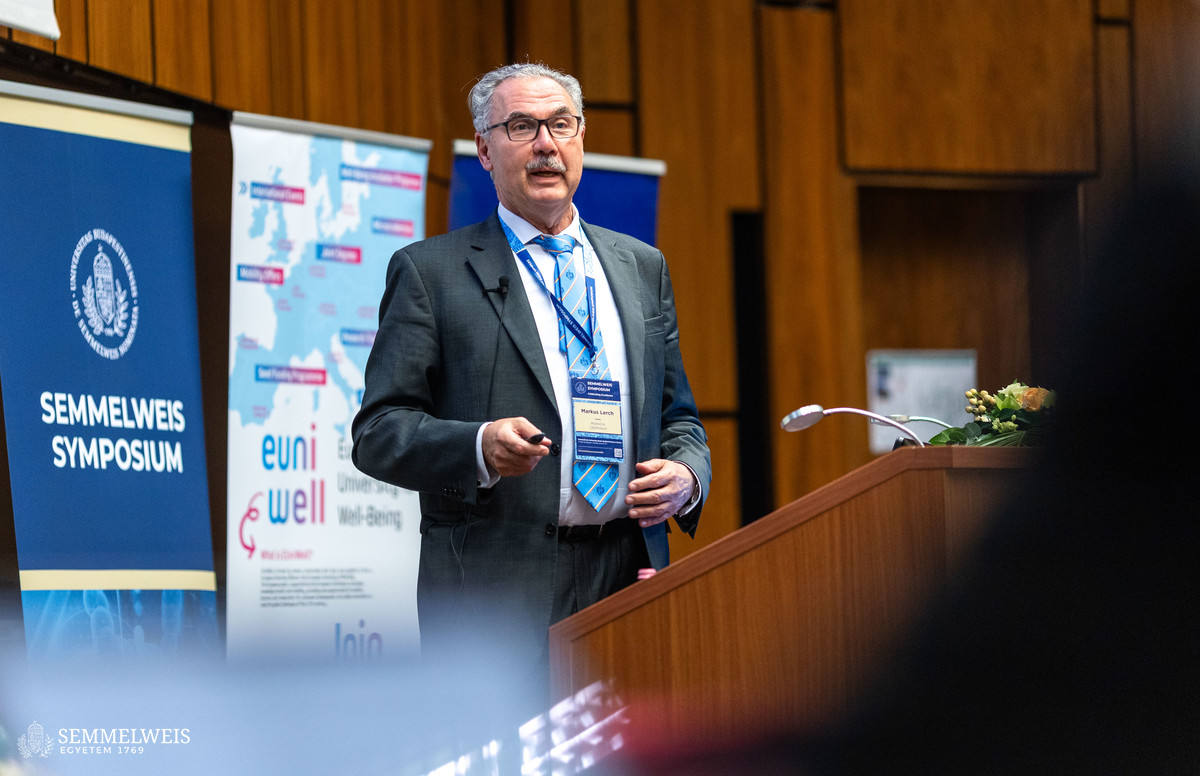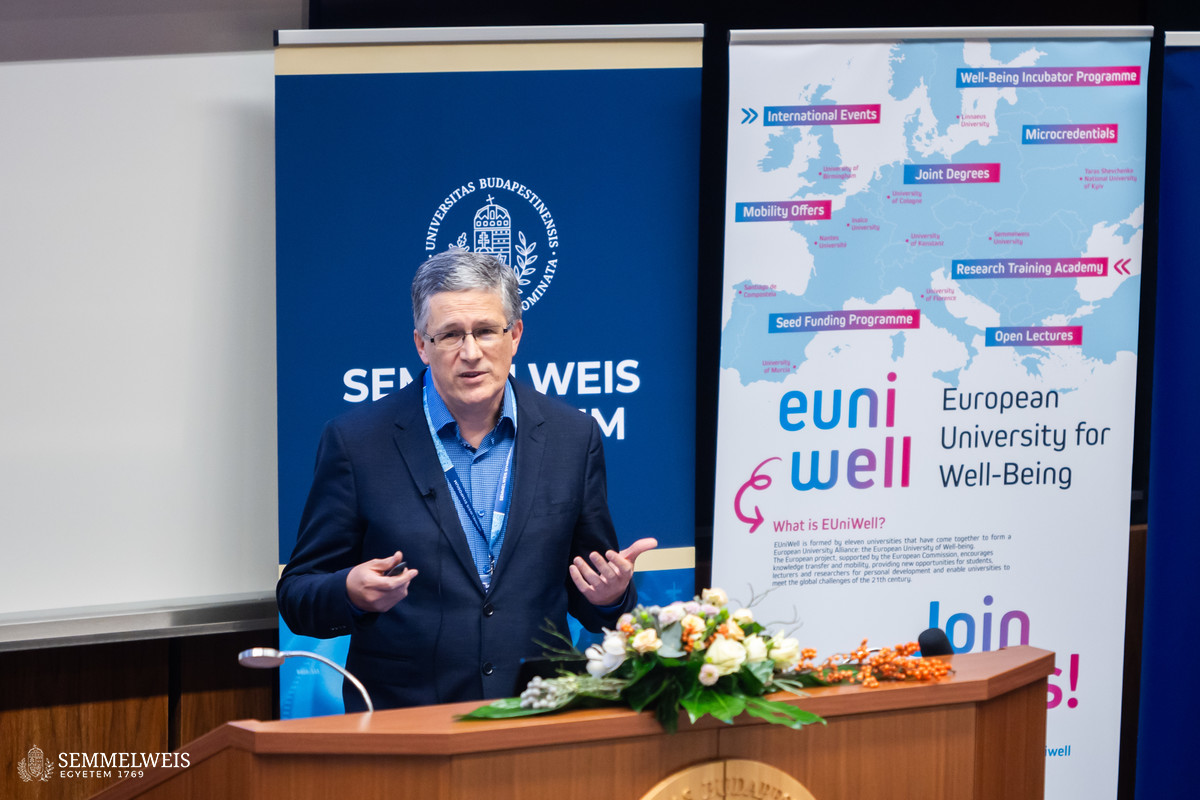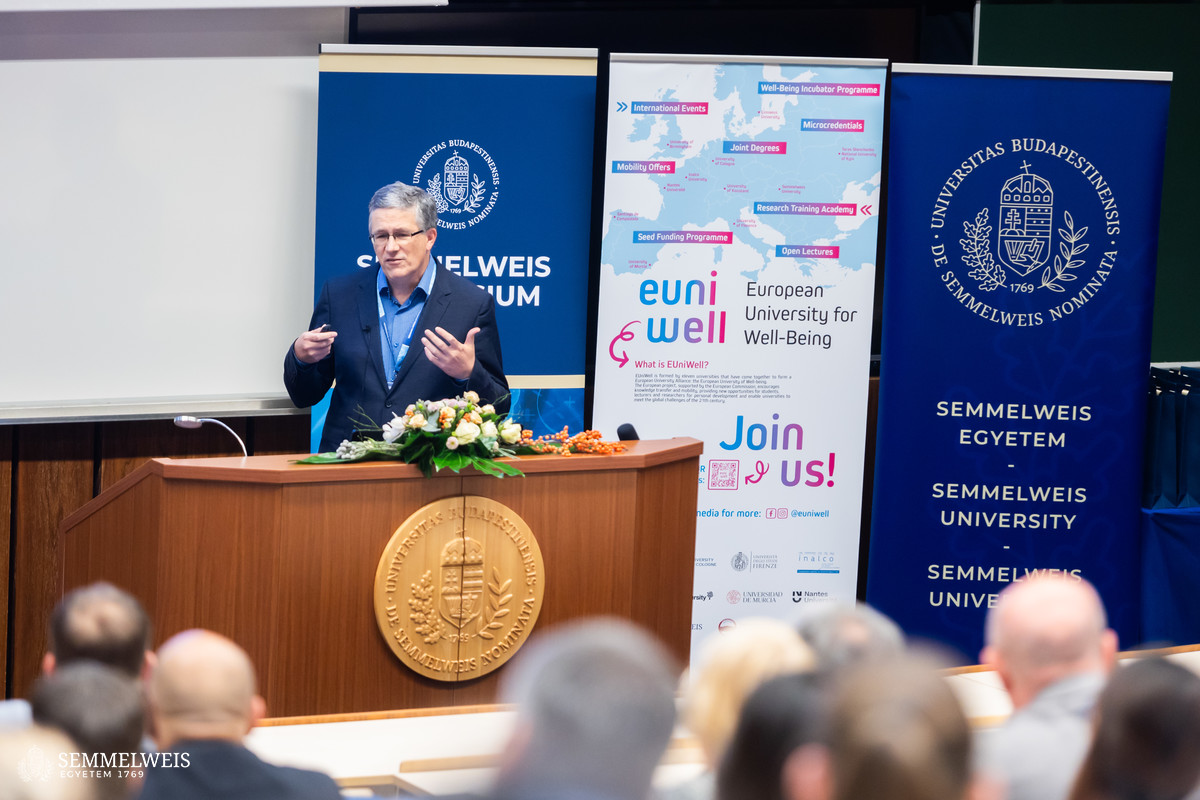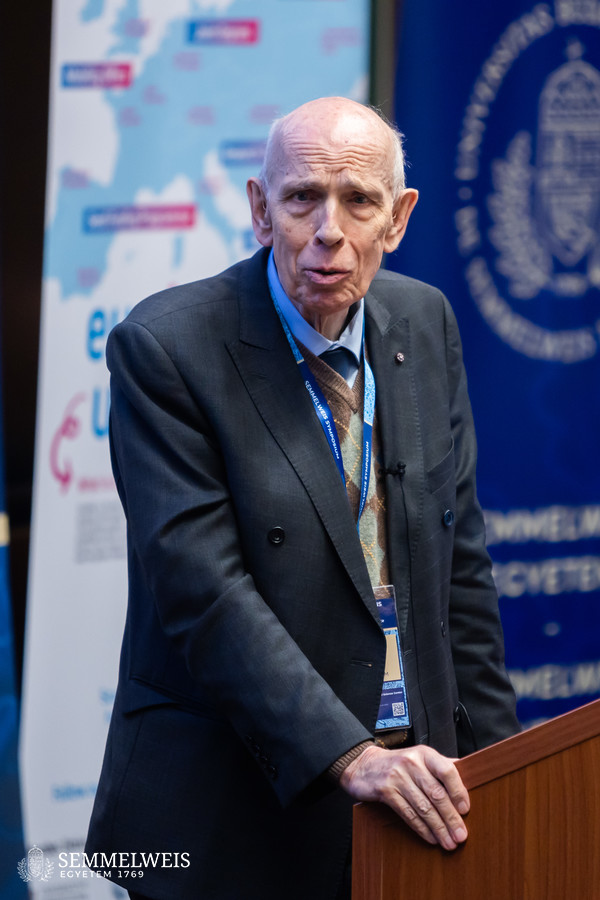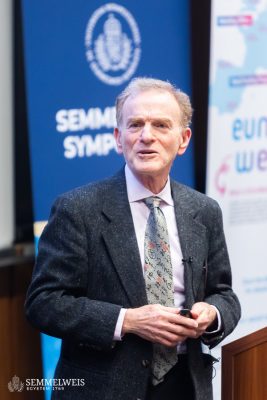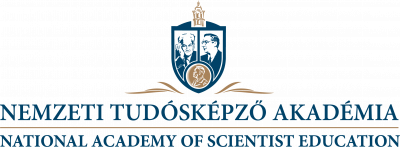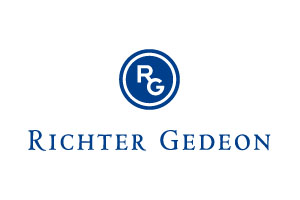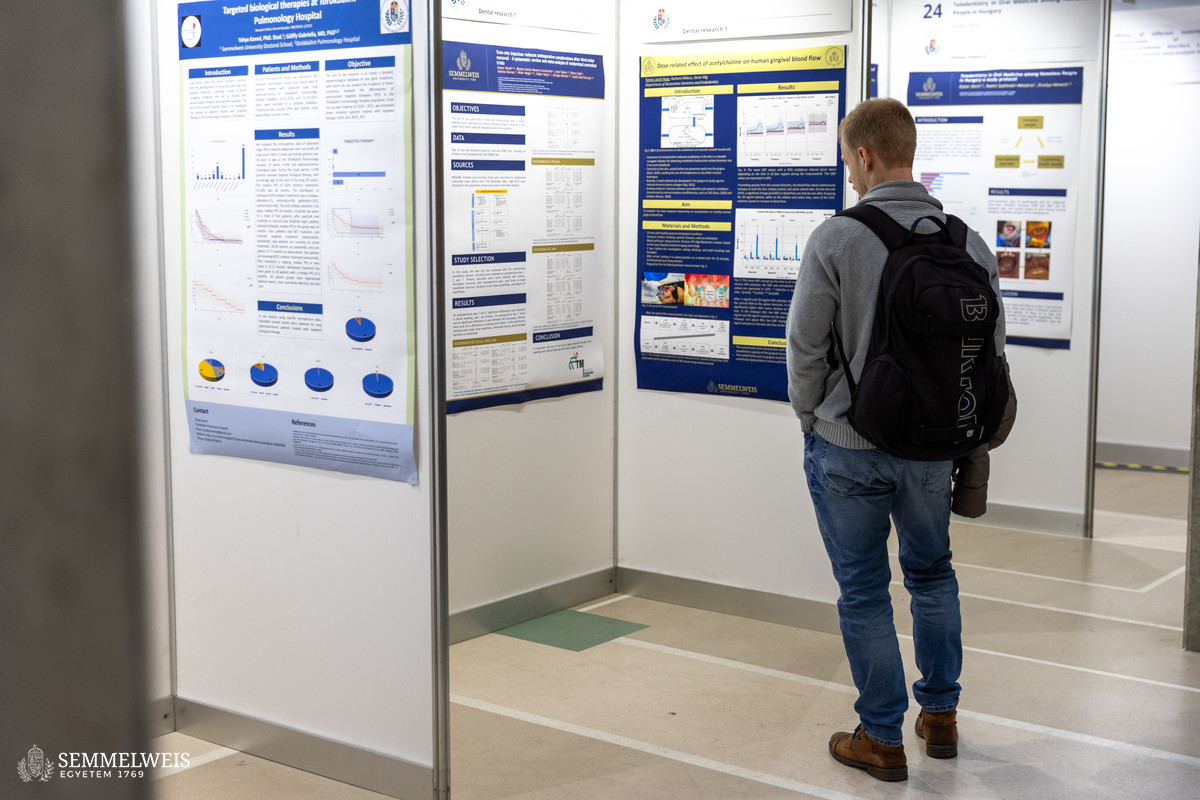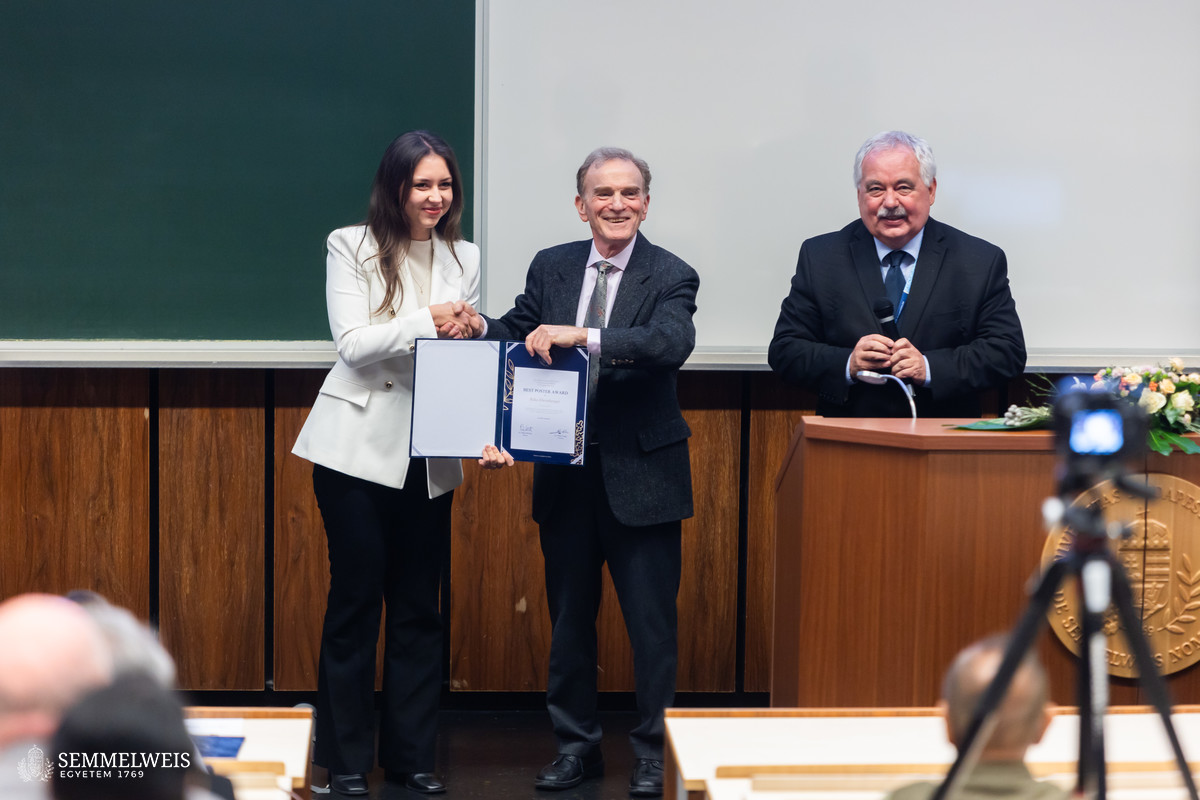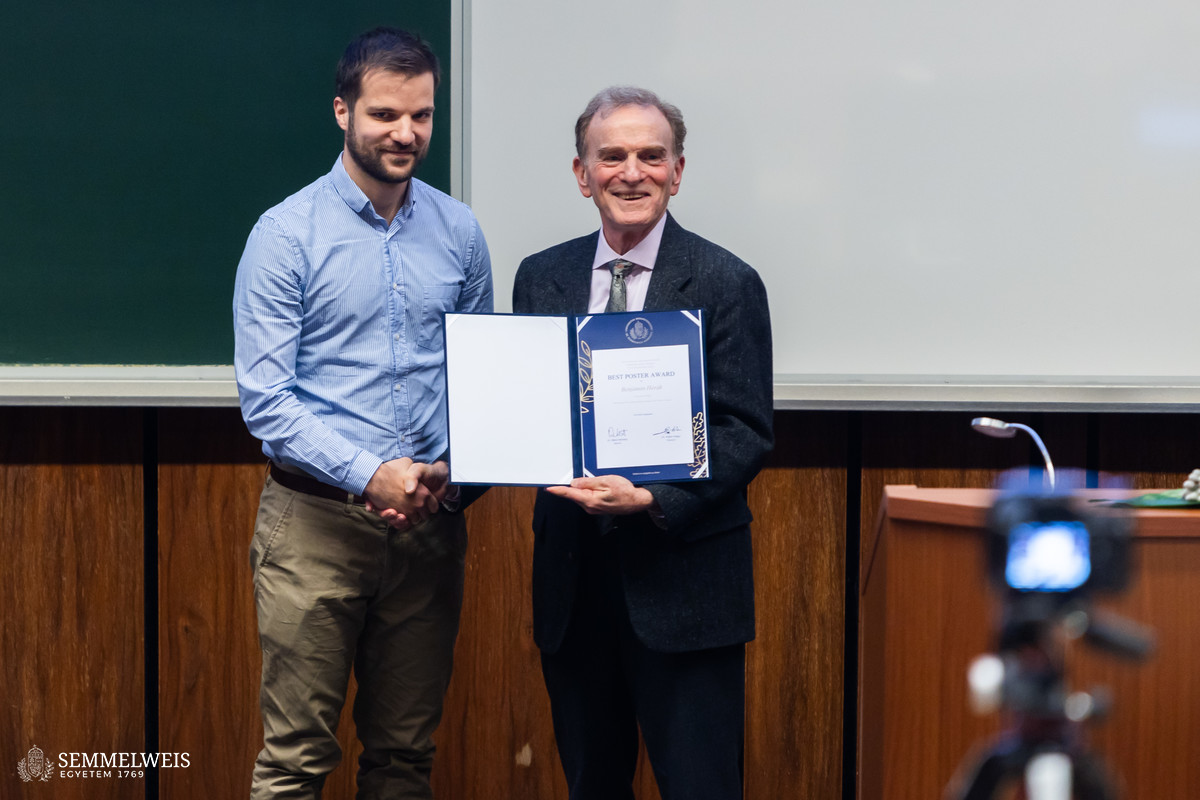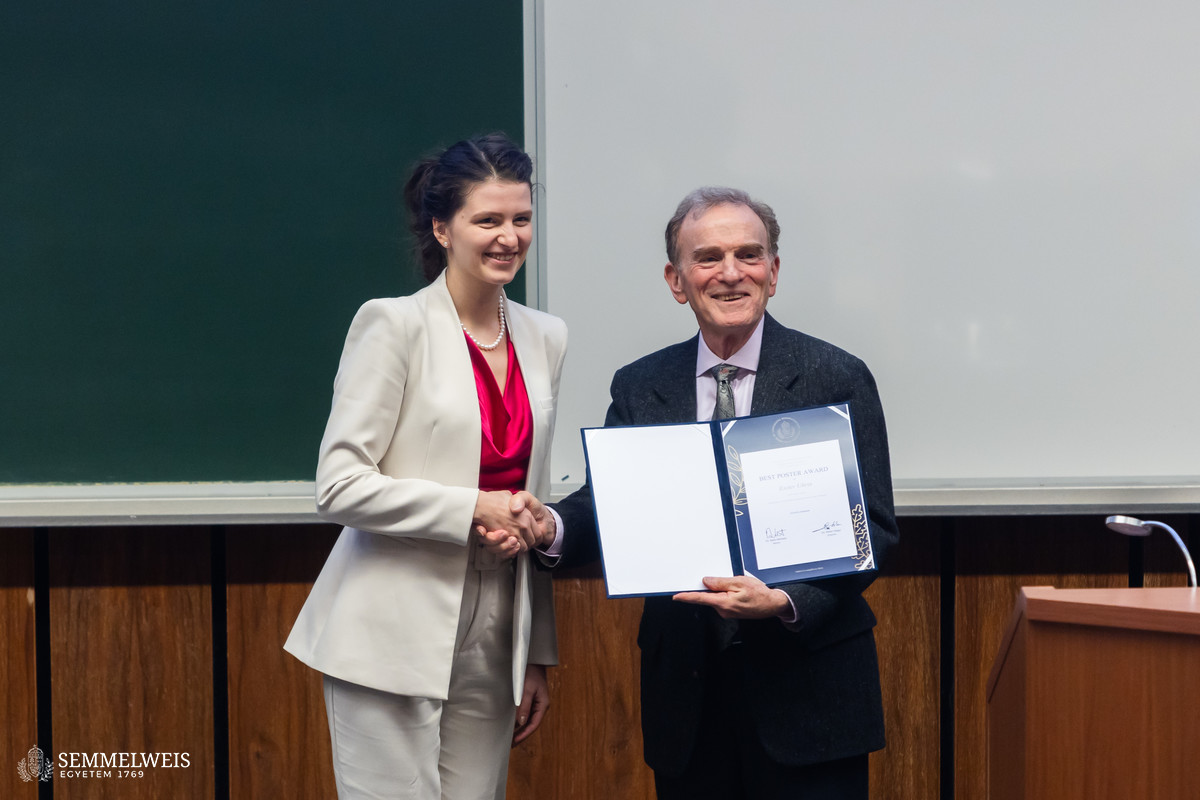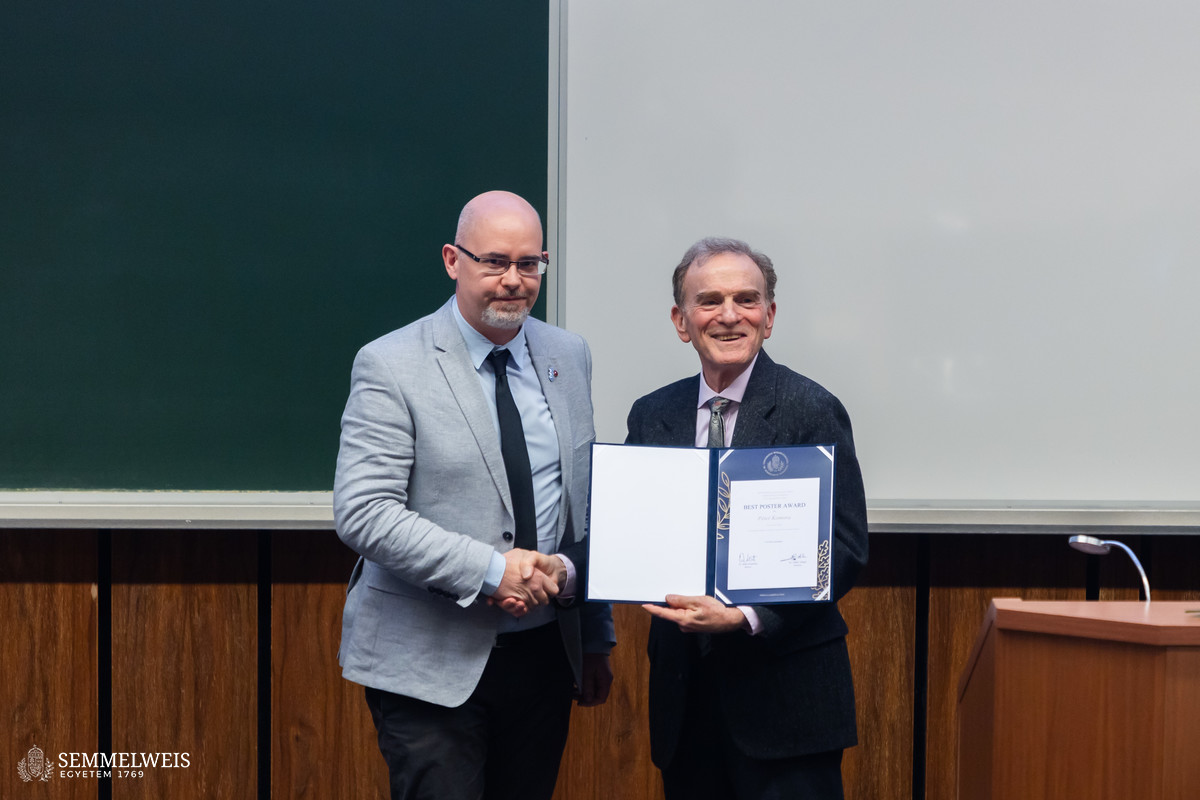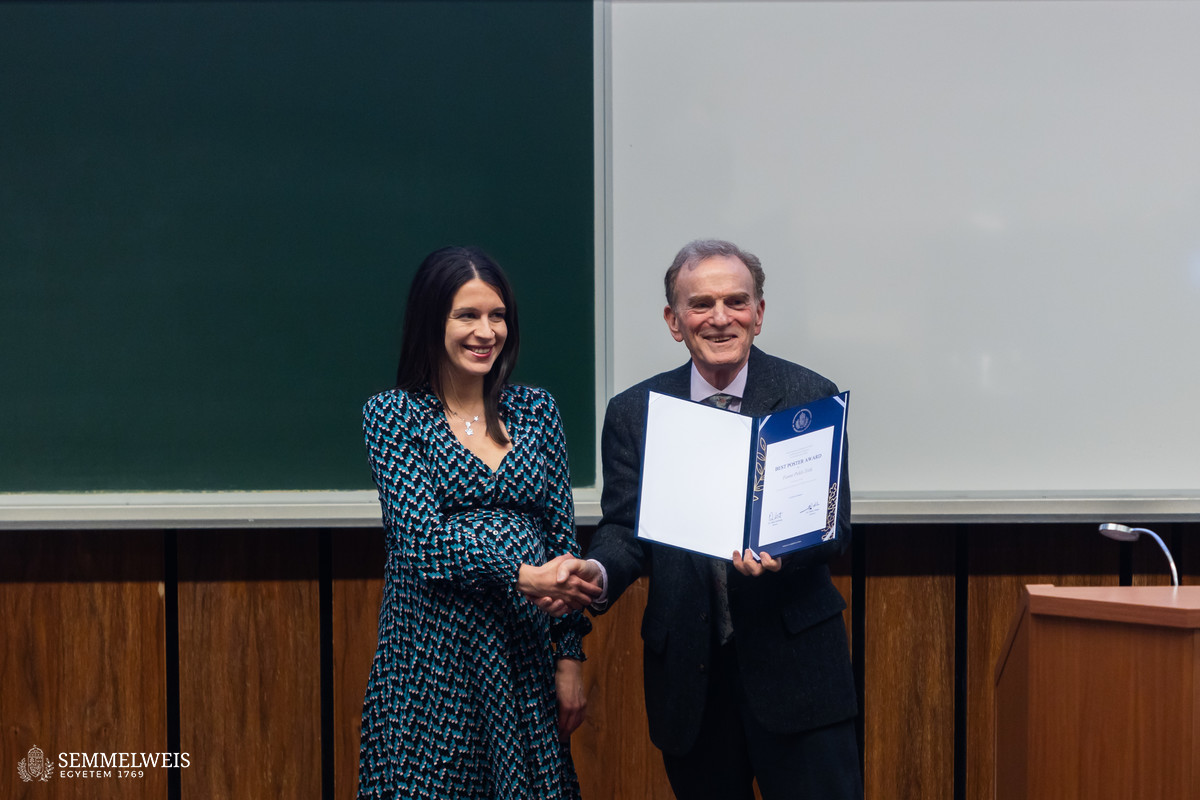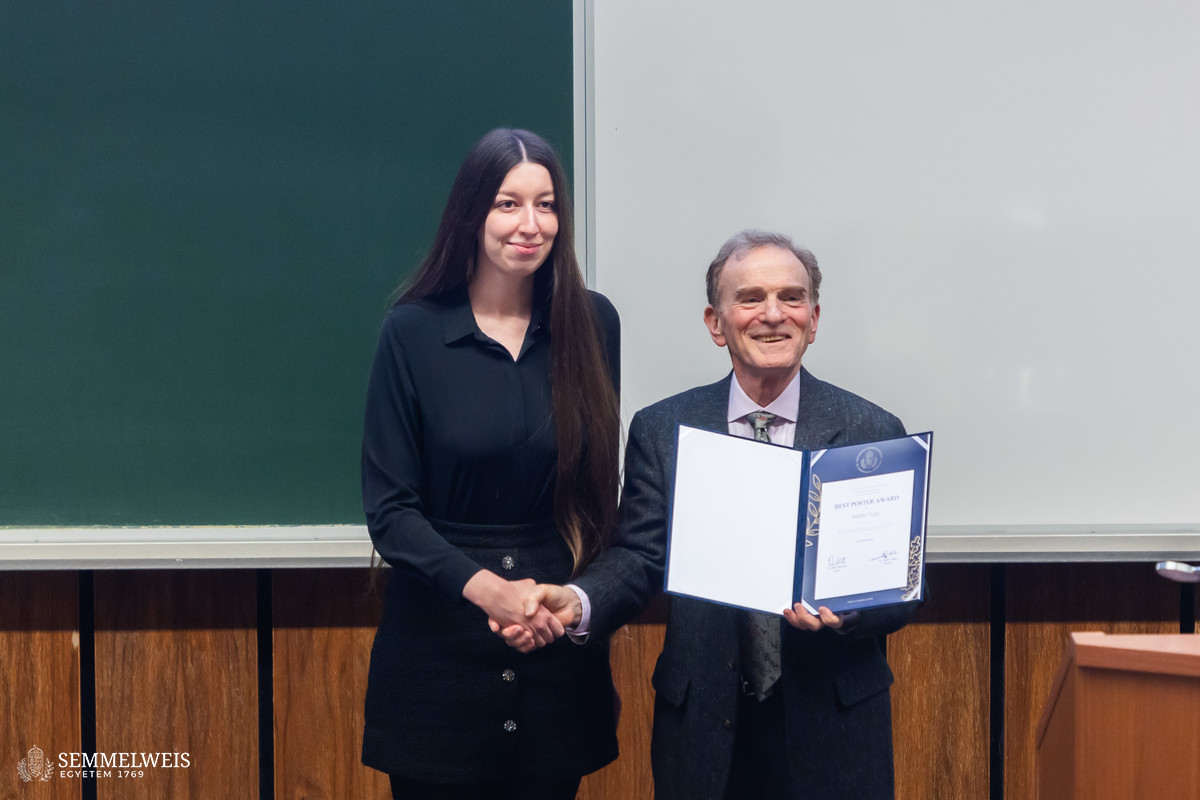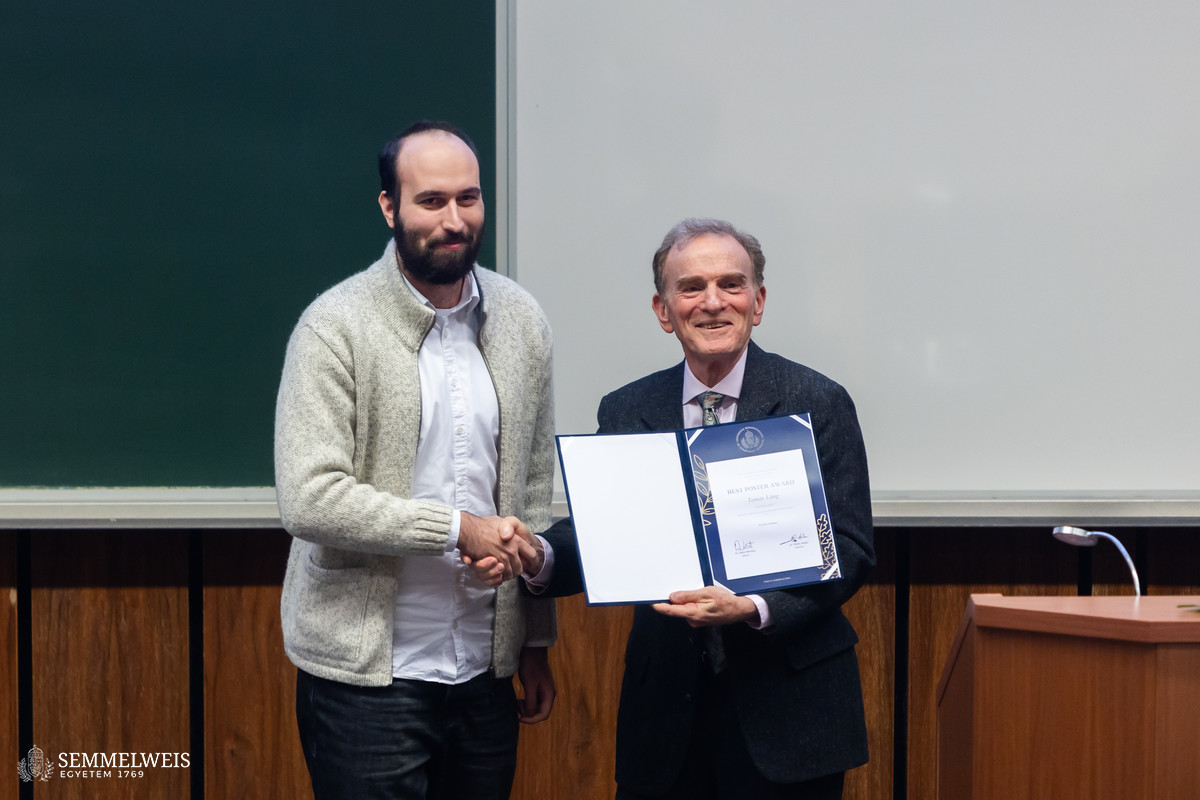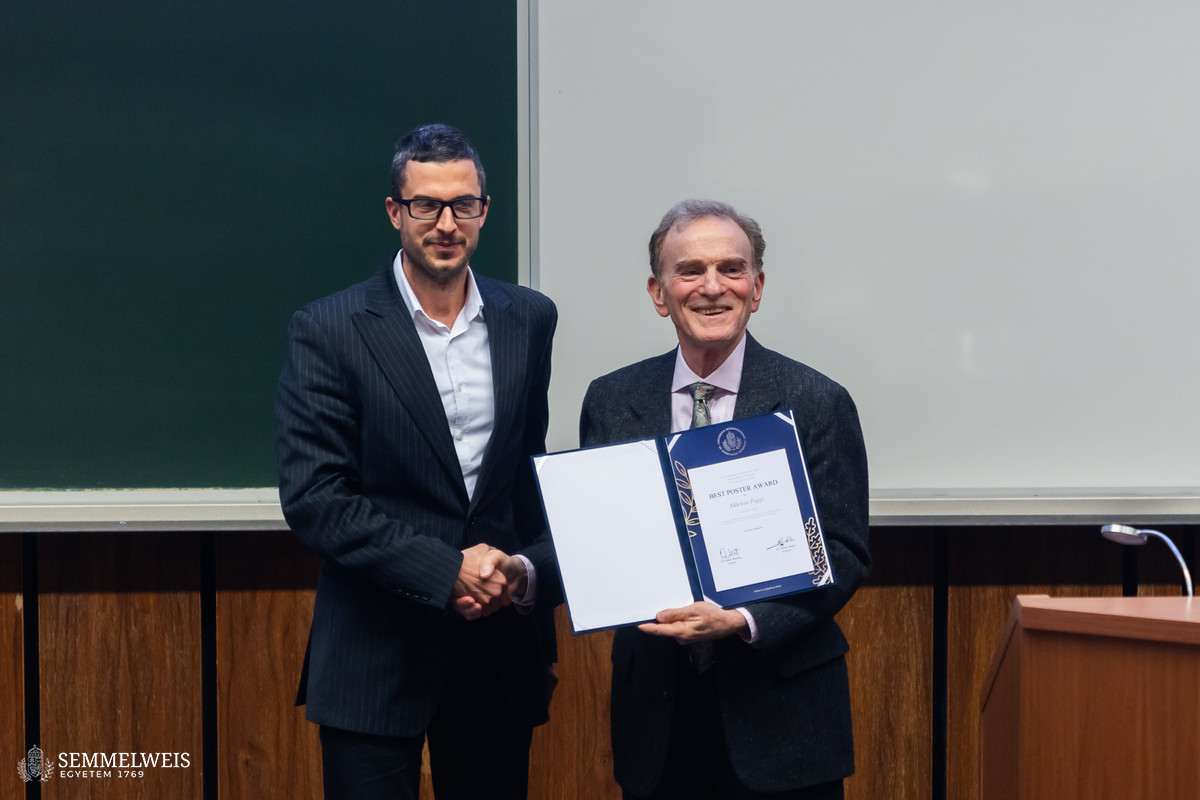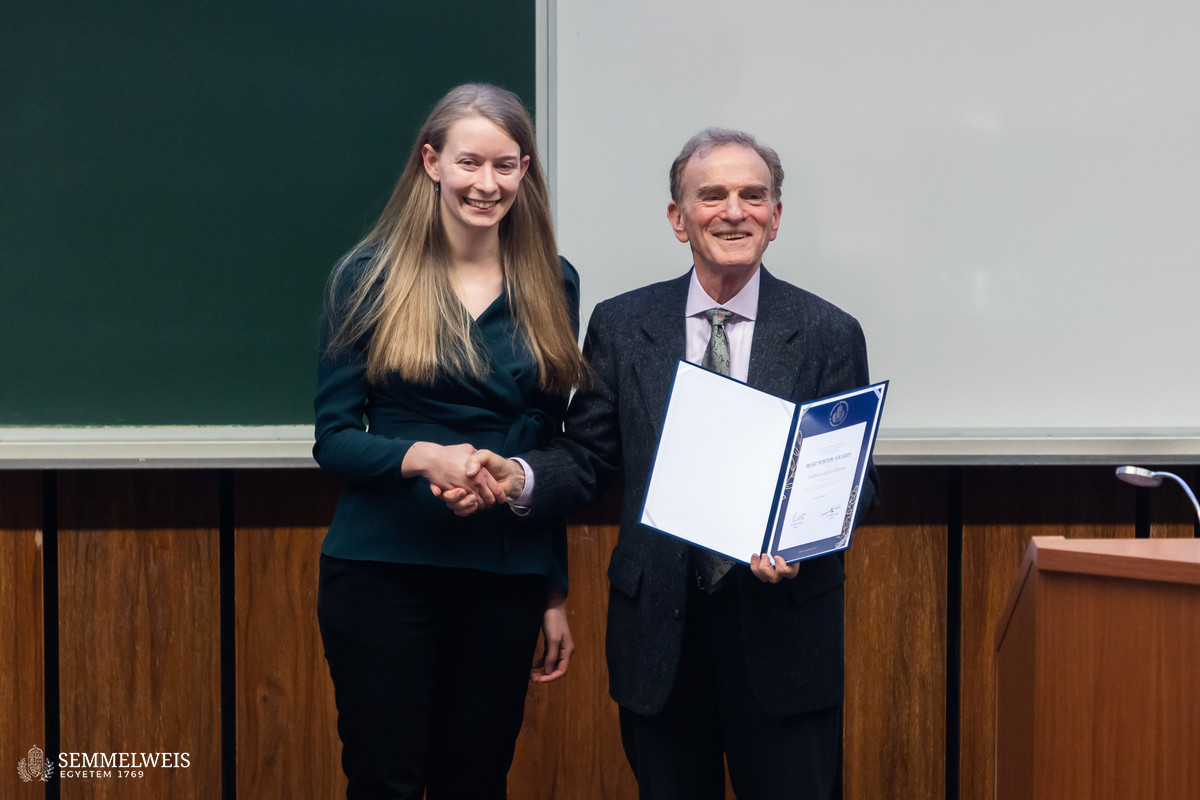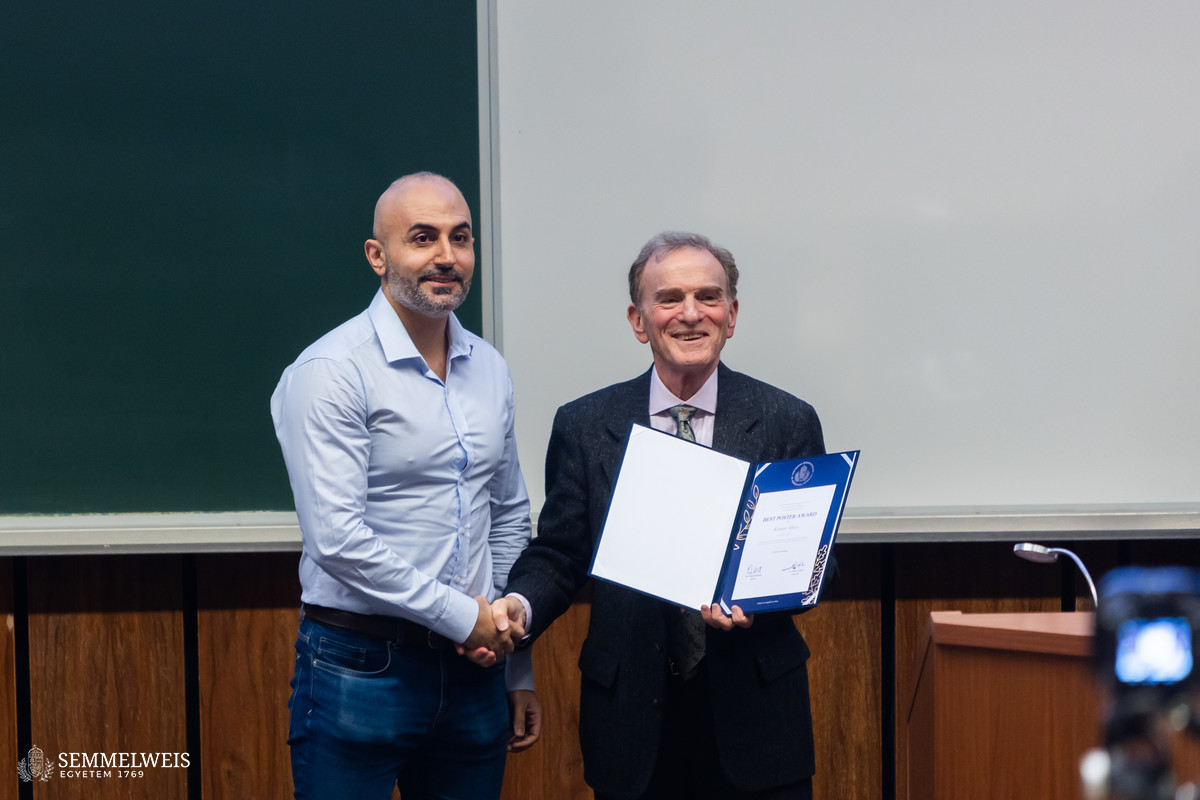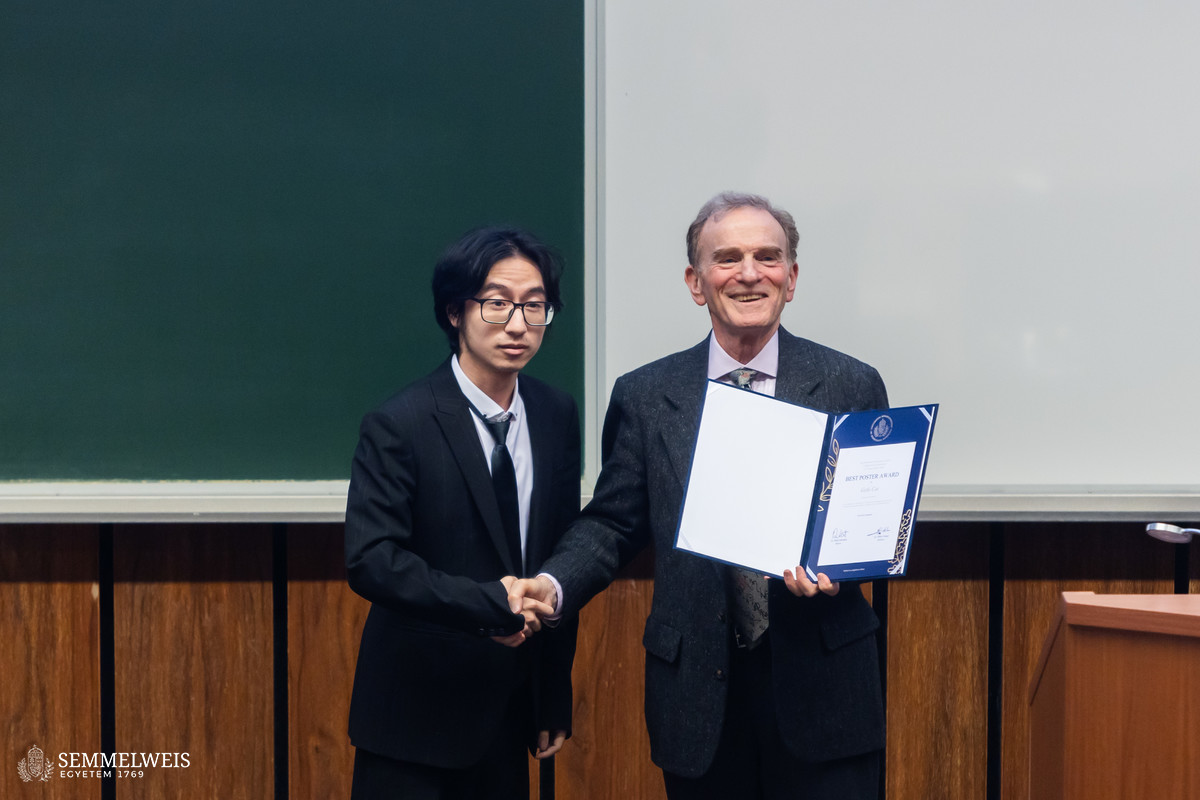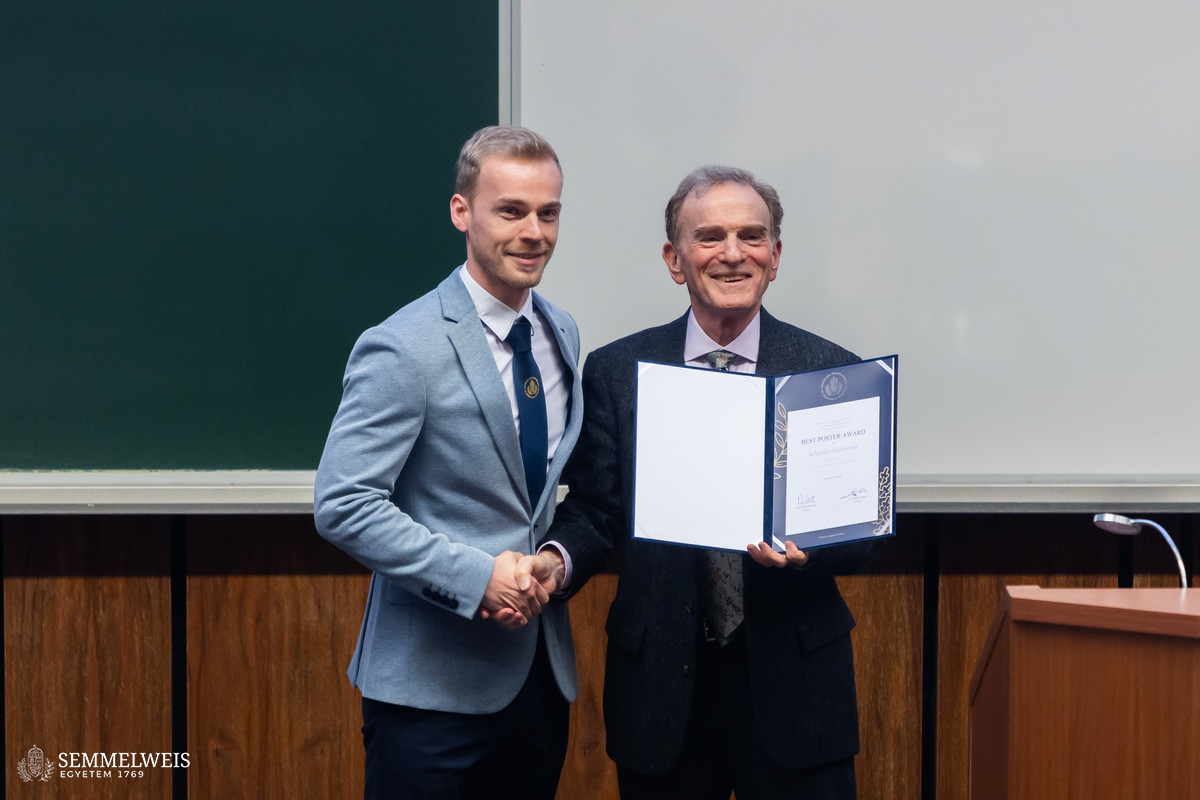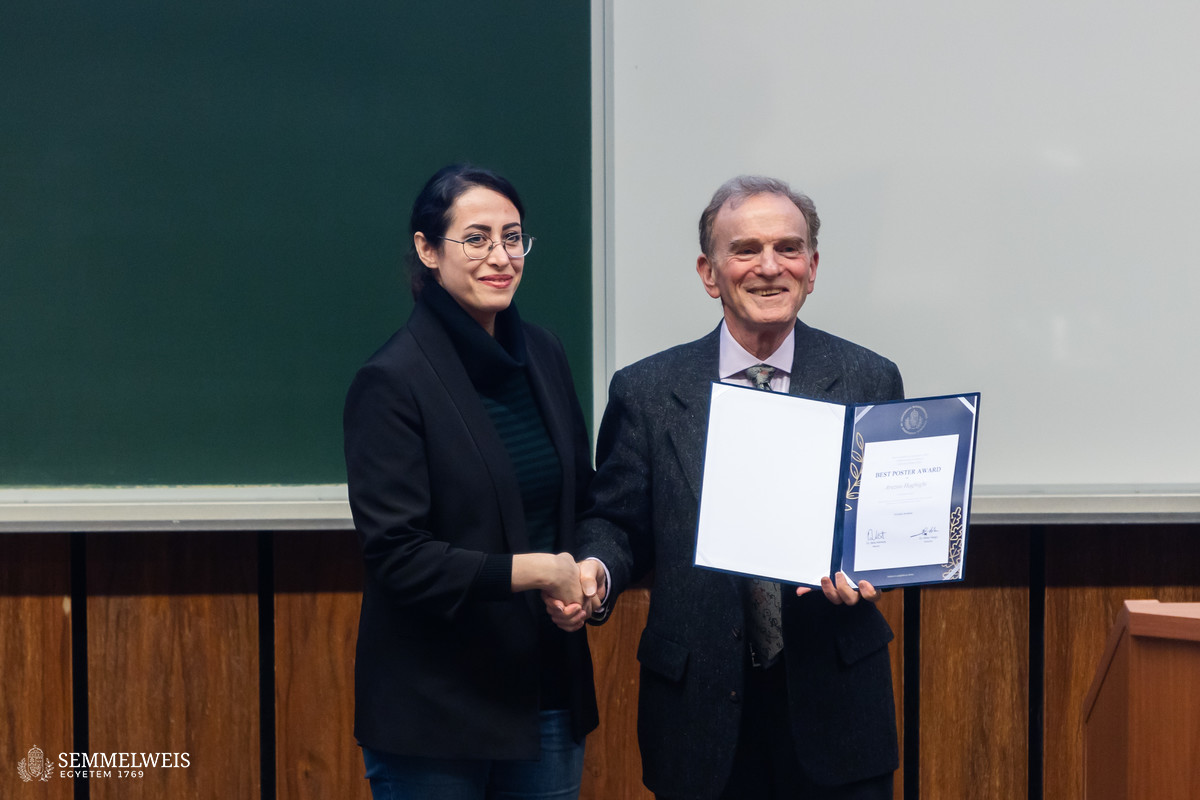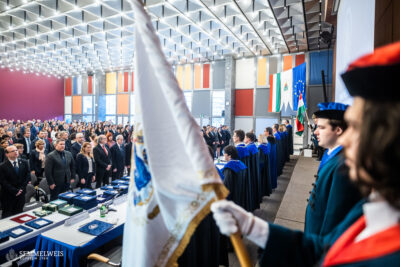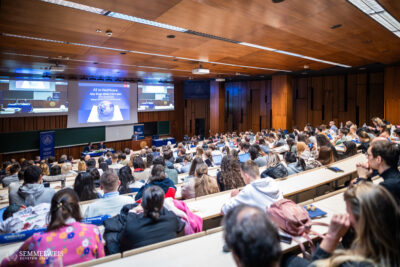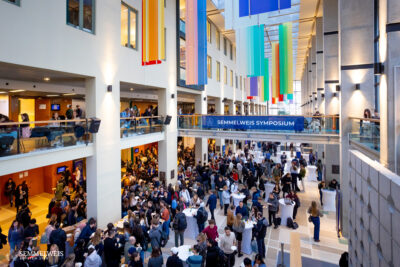Symposium, 2nd day: from the „up and down” regulation to personalized medical care
In the first session of the second day, the basic research aspects of pancreatic diseases were discussed. Dr. Mark Lowe (St. Louis, USA) presented an animal model in which the up and down regulation of genes was studied. The PNLIP p.Thr221Met mouse model is a chronic pancreatitis one based on protein misfolding, which well demonstrates the molecular pathways leading to cell death, and raises a therapeutic possibility based on the proper folding of proteins. Dr. Andrea Geisz from Boston demonstrated the pathological role of the cerulein induced early enzyme activation of intrapancreatic trypsin in acute pancreatitis and in the development of the disease into a chronic one using a cerulein-induced mouse pancreatitis model. Dr. Julia Mayerle demonstrated the role of sphingomyelinase in pancreatic ductal adenocarcinoma. Dr. Balázs Németh (Szeged) gave a lecture on the genetic background of acute pancreatitis and detailed the Hungarian possibilities in the field of genetic counseling. Dr. Eszter Hegyi (Pécs) studied protein misfolding in acute pancreatitis using four preclinical mouse models.
In the second section, the main focus was on various pancreatic neoplasms. Dr. Diane Simone from New York presented the PRECEDE international collaboration, which represents a breakthrough in the early diagnosis and prevention of pancreatic ductal adenocarcinoma (PDAC), and thus aims to quintuple the 5-year survival within 10 years. Dr. Tamás Gonda, also from New York, presented various diagnostic methods for pancreatic neoplasms, with a focus on endoscopic ultrasound, on which he showed several interesting videos to the audience. Dr. Chenchan Huang (New York, USA) presented on the imaging diagnostics of PDAC, in her presentation she discussed the advantages of different modalities and the role of artificial intelligence in the radiology of the future, supplemented with other biomarkers. Dr. Hana Algül (Munich, Germany) gave a lecture on the molecular genetic diversity of PDAC, the indications for genetic screening (family member with PDAC, acute pancreatitis, newly discovered diabetes mellitus, etc.), highlighted the importance of sequential treatment, presented the latest developments in targeted (KRAS inhibitor) therapy, and predicted the importance of immunotherapy in the future using the vaccination method. Dr. Srikanth Iyer (Birmingham, USA) demonstrated the Notch molecular pathway in the L-arginine mouse model. In chronic pancreatitis, this pathway is enhanced, primarily via macrocytes, and its inhibition in an animal model leads to an improvement in the parameters of the disease.
The third session was opened by Dr. Bálint Erőss (Budapest), who began with a dramatic case study that drew attention to the relationship between chronic and acute pancreatitis, emphasizing the importance of preventing recurrent acute pancreatitis (RAP), which can prevent the development of chronic disease. Dr. Jonas Rosendahl (Halle, Germany) presented the pathways of early development of PDAC, primarily highlighting inflammation, epigenetic plasticity and tissue remodeling. Dr. Vikas Dudeja (Birmingham, USA) presented a basic research and clinical study of pirferidone, an anti-inflammation and fibrosis medication, in acute pancreatitis. Dr. Theodore Welling (New York, USA) explained the genetic characteristics of PDAC, highlighting the possibility of real-time small nuclear RNA sequencing in clinical practice, which can facilitate therapeutic decisions. Dr. Zoltán Rakonczay outlined a new pancreatitis model, and his research proves that human fetal pancreatic tissue (20-24 weeks of gestation) and organoids are suitable ductal models for functional research related to the CFT receptor, for example.
In the fourth session, Dr. Thomas Gress presented the German follow-up program that examines individuals at high risk for hereditary PDAC. Follow-up and screening make it possible to detect this serious, high-mortality disease in time, thereby increasing the chance of survival. The disadvantage of the program is “overdiagnosis”, which means that harmless lesions are also subjected to surgery. Dr. Pramod Greg from New Delhi gave a lecture on the proper treatment of acute pancreatitis, in which he emphasized early fluid replacement, enteral nutrition and pain relief, and highlighted there is no need for prophylactic antibiotics. In his presentation, he also described the targeted therapies under research. Dr. Vinciane Rebours from Clichy (France) spoke about the PDAC epidemic, in her presentation she listed the reasons for the increasing incidence, which included an aging society, an inactive lifestyle, an inadequate composition of the diet and environmental pollution. Dr. Markus Lerch (Munich, Germany) gave a lecture on the relationship between pancreatitis and microbiota. His research showed that there is a strong association between elastase produced by the pancreas, i.e. exocrine pancreatic function, and microbiome diversity and stability. At the end of the second day, Dr. David Witcomb (Pittsburg, USA) gave a lecture on personalized medicine, the basis of which is genetics, for which the single nucleotide polymorphism technology provides an available opportunity to study. The company founded by the researcher provides services for the diagnosis of diseases of various organ systems and the determination of individual pharmacokinetic properties.
Symposium, 3rd day: from CFTR canal receptor inhibition to a Nobel Prize-winner’s presentation
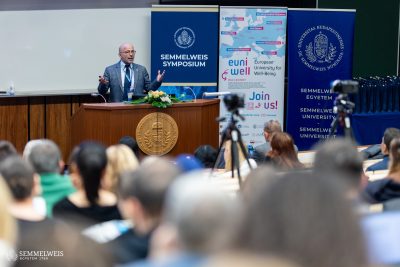 On the third day of the Semmelweis Symposium, researchers from Budapest presented their studies in the first session. Dr. Petra Pallagi studied the effect of heavy metals ingested during smoking in the inhibition of the CFTR canal receptor, which leads to the development of chronic pancreatitis. Dr. Adrienn Kéri presented her data on the prevalence of reduced glucose tolerance among children with cystic fibrosis. Continuing this theme, Dr. Andrea Párniczky gave a lecture on cystic fibrosis-related diabetes and the ways and routes of the development of reduced glucose tolerance. Dr. Rita Nagy presented the importance of evidence-based medicine in relation to pancreatitis, with data from international and domestic surveys. Dr. Szilárd Váncsa gave a lecture on metabolic fatty liver in acute pancreatitis; based on his results, metabolic fatty liver is related to the severity of pancreatitis, and the outcome of pancreatitis depends on its degree. In Dr. Péter Jenő Hegyi’s presentation, we heard about whether anticoagulant therapy is necessary and safe for patients suffering from acute pancreatitis, and what type of medicine is recommended. Overall, he recommends low-molecular-weight heparin, since in his research, these reduced the mortality, organ failure, and length of hospitalization in moderate-to-severe pancreatitis.
On the third day of the Semmelweis Symposium, researchers from Budapest presented their studies in the first session. Dr. Petra Pallagi studied the effect of heavy metals ingested during smoking in the inhibition of the CFTR canal receptor, which leads to the development of chronic pancreatitis. Dr. Adrienn Kéri presented her data on the prevalence of reduced glucose tolerance among children with cystic fibrosis. Continuing this theme, Dr. Andrea Párniczky gave a lecture on cystic fibrosis-related diabetes and the ways and routes of the development of reduced glucose tolerance. Dr. Rita Nagy presented the importance of evidence-based medicine in relation to pancreatitis, with data from international and domestic surveys. Dr. Szilárd Váncsa gave a lecture on metabolic fatty liver in acute pancreatitis; based on his results, metabolic fatty liver is related to the severity of pancreatitis, and the outcome of pancreatitis depends on its degree. In Dr. Péter Jenő Hegyi’s presentation, we heard about whether anticoagulant therapy is necessary and safe for patients suffering from acute pancreatitis, and what type of medicine is recommended. Overall, he recommends low-molecular-weight heparin, since in his research, these reduced the mortality, organ failure, and length of hospitalization in moderate-to-severe pancreatitis.
The second session was opened by Dr. Minoti Apte from Sydney (Australia). In her lecture, she talked about the pancreas that suffered “combat injuries”, focusing on the role of stellate cells. Based on her research, stellate cells play a major role in therapeutic options due to their stromal reprogramming ability. Dr. Ashok Saluja (Miami, USA) reported on the therapeutic options for pancreatic tumors; in his presentation he talked about chemotherapy, immunotherapy, surgical solutions and the triptolide-containing medicine researched by his own team, which is a Chinese plant’s (Tripterygium wilfordii – “thunder god vine”) active ingredient. He concluded his presentation with a message emphasizing the importance of mentorship and drew attention to the fact that we should live our everyday lives in such a way as to bring positive change to the world. The next presentation was held by Dr. Ashok Saluja’s mentee, Dr. Vijay Singh (Phoenix, USA), who talked about the molecular and clinical consequences of pancreatic injury. The mechanism is based on the lipotoxic effect mediated by the necrosis of unsaturated fatty acids produced by the release of pancreatic enzymes, which cause organ failure when they enter the circulation. Dr. Alexei Tepikin (Liverpool, UK) reported on calcium transport pathways, which play an important role in exocrine organs such as the pancreas. Abnormalities of the pathway can lead to defects in endocytosis and autophagy in acinar cells, which are important mechanisms in pancreatitis.
The first lecture of the third session was given by Dr. Pawel Ferdek (Krakow, Poland), who spoke about exocrine diseases of the pancreas, presenting new therapeutic options. Dr. Shmuel Muallem (Bethesda, USA) spoke about phosphatidylserine nanodomains and bicarbonate transporters at the border of the endoplasmic reticulum and the plasma membrane, which can play a role in the targeted treatment of pancreatic ductal adenocarcinoma. Dr. Viktória Venglovecz (Szeged) gave a lecture on the role of the CFTR modulator Orkambi drug in alcoholic pancreatitis, which is also used in cystic fibrosis. Based on her results, the drug restores the reduced CFTR function and activity caused by alcohol and may also reduce the severity of the disease in experimental models. In his presentation, Dr. József Maléth (Szeged) discussed the latest therapeutic options for chronic pancreatitis by presenting the translation possibilities to clinical practice based on basic research, among other things, about the preclinical results of orai1 inhibitor and plasminogen activator inhibitor therapies and the ongoing clinical trials. Dr. Sabeeha Merchant (Berkeley, USA) gave her presentation on the role of copper as a micronutrient and enzyme catalyst. She also talked about the lack and excessive presence of copper. The chlamydomonas photosynthetic cell is a reference system for the lack of elemental substances, in the case of copper deficiency, the compensation is carried out by the expression of various proteins with the help of transcription factors and genes. In copper overload, the excess material is sequestered and stored in mobile form in lysosomes.
In the last, highlighted section of the symposium, Dr. Miklós Sahin-Tóth (Los Angeles, USA) gave a summary of his life work on hereditary pancreatitis. His presentation discussed the human genetic studies during which the cationic trypsinogen gene was discovered, and the autoactivation of trypsin was demonstrated through functional research. Animal models can be used to experimentally set up acute and chronic pancreatitis models. Finally, therapeutic targets developed by preclinical research were presented in this hereditary disease. Dr. Ole Petersen (Cardiff, UK) reported on the physiological and pathological role of pancreatic mitochondria on the occasion of the 70th anniversary of the mitochondrial ultrastructure described by George Emil Palade. In his presentation, he introduced the researchers who participated in any way in the discovery of the mitochondrion, its channels, and other elements, and also talked about their mechanism.
Nobel Prize-winning scientist Dr. Randy Schekman (Berkeley, USA) reported on the basic research areas of Parkinson’s disease at the molecular and cellular level. The topic of his presentation is a new area of interest related to family tragedy and the resulting international collaborative research work. Despite the “pandemic” of Parkinson’s disease, we do not have a drug curative therapy that is suitable for everyone, and this may be due to the wide spectrum of the disease. Genetic studies provide a good opportunity to solve this problem. The PINK1 and Parkin genes recognize and clean up damaged mitochondria, the GDNF gene is involved in neuroprotection.
In his presentation, he explained the story of his deceased wife and his frustration with the fact that despite his Nobel Prize, he could not help her with this serious neurological disease. Together with several wealthy families and foundations affected by this disease, he founded a research network (ASAP Network), with the help of which Parkinson’s disease is systematically researched. Many professional and non-professional, diverse members of the collaboration have set themselves the goal of putting together the “puzzle” of this widespread, multisystemic disease, starting with genetics, through neuroimmunology and nervous system studies to the search for immune and intestinal system symptoms. In addition, since non-motor symptoms may precede diagnostic criteria by up to 20 years, their assessment may lead to earlier diagnosis and the development of further new research areas. The scientist emphasized the essential importance of cooperation and teamwork.
The results of the poster competition that was part of the symposium were announced in the last section. The organizers received 135 poster abstracts, which were then exhibited during the event. The projects were competed in 14 sections, those awarded with the 1st prize received their certificates from Dr. Randy Schekman. The list of awardees can be found by clicking here.
“It is an honor for me that we could celebrate excellence together at our university’s traditionally most prestigious scientific event, which we have organized every year since 1992,” concluded the three-day event Rector Dr. Béla Merkely.
Sponsors:
Source: Semmelweis University, Institute of Pancreatic Diseases
Translation: Mária Sánta
Photo: Bálint Barta, Attila Kovács – Semmelweis University
